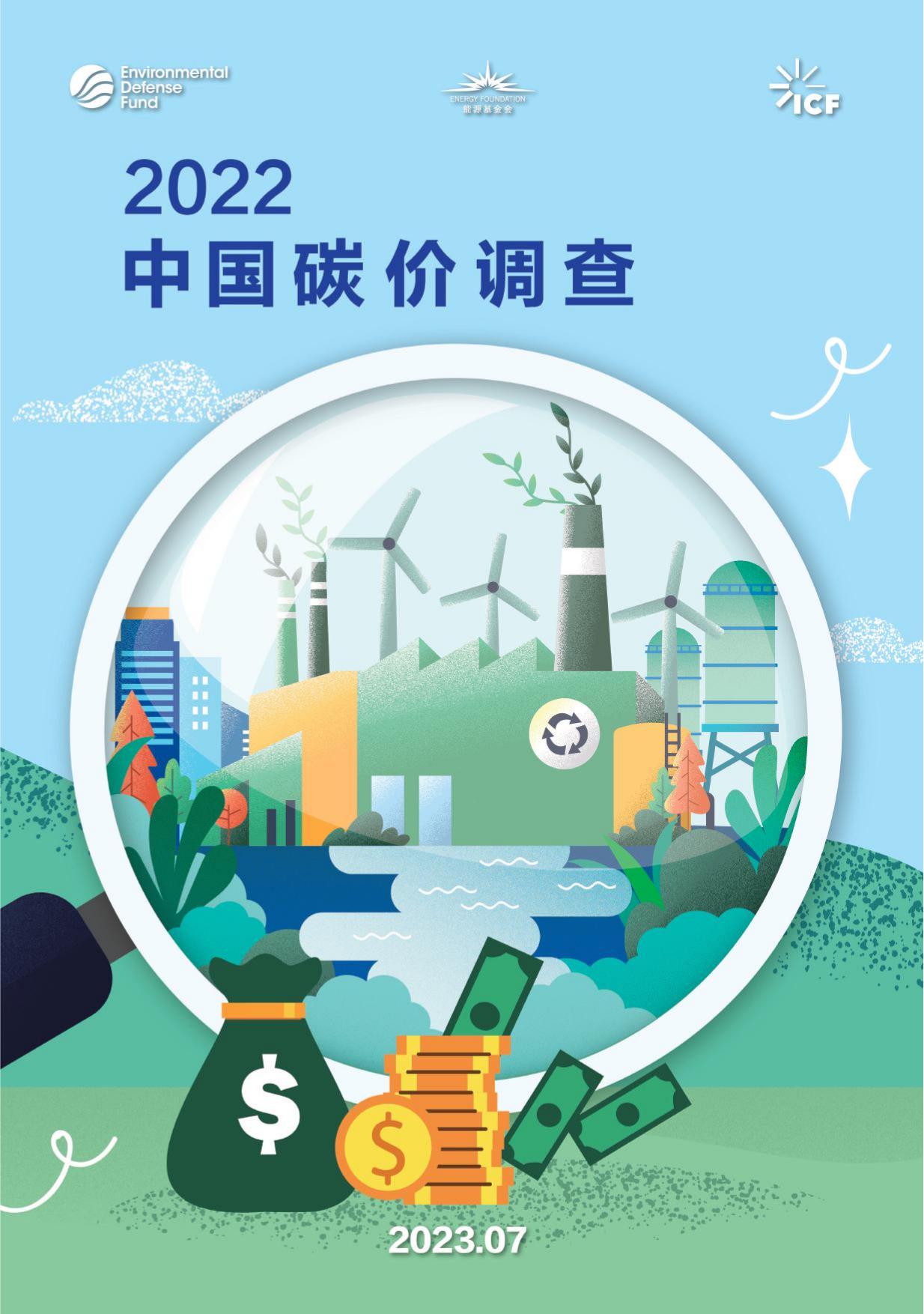I摘要本报告总结了《2022年中国碳价调查报告》的成果。此次调查于2022年10-11月展开。在此期间,项目团队与行业协会合作,对来自已经受到或即将受到碳价影响的中国碳密集型行业的行业代表,尤其是来自中国全国碳排放权交易体系首个覆盖行业——发电行业的代表,进行了广泛的调查。除发电行业外,水泥行业和钢铁行业被认为是对加入全国碳排放权交易体系准备最为充分的重点排放行业。从调查的结果来看,水泥行业和钢铁行业被认为最有可能在2024年前纳入全国碳排放权交易体系。超过40%的发电行业受访者预计,其所在企业将需要从市场上购买配额来完成第二个履约周期(注:2022-2023年)的履约。本次调查结果显示,受访者坚信,随着时间的推移,中国的碳价水平将逐步上涨,且碳价对投资决策的影响也会日益增加。受访者还对中国在2030年实现碳排放达峰目标表现出极大的信心。关键词碳价,碳排放交易,碳市场,公共政策,利益相关方调查,中国推荐引用Slater,H.,王庶,黎瑞鑫,《2022年中国碳价调查报告》,2023年2月,ICF,北京通讯地址地址:中国北京市朝阳区建国门外大街2号北京银泰中心C座3125单元,邮编100022电邮:chinacarbonpricing@icf.comII致谢:本调查由ICF国际咨询公司开展,美国环保协会、能源基金会和挪威环境局给予了大力支持。报告执笔人感谢所有为本报告作出贡献的其他组织和个人。我们也非常感谢以下行业协会、企业及其代表协助发放调查问卷:中国电力企业联合会、中国有色金属行业协会、中国建筑材料集团有限公司、中国建筑材料联合会、冶金工业规划研究院以及中国石油和化学工业协会。感谢ICF国际咨询公司的贾士伟对本调查项目的执行和项目管理提供的大力支持。中国碳论坛与澳大利亚国立大学的FrankJotzo教授一起发起了2013年的首次调查,并随后负责管理后续调查项目的执行,直至2020年。多年来,中国碳论坛总经理卫诚然(PeterEdwards)为调查提供了宝贵的支持,报告执笔人对此表示由衷的感谢。III目录目录..............................................................................................................................................................III执行摘要.......................................................................................................................................................V概述...............................................................................................................................................................1中国碳排放交易动态...................................................................................................................................3调查受访者...................................................................................................................................................6全国碳排放权交易体系...............................................................................................................................9碳价预期.....................................................................................................................................................17自愿碳市场/抵消机制...............................................................................................................................21排放交易的准备程度.................................................................................................................................23碳价对投资的影响.....................................................................................................................................28碳边境调节机制.........................................................................................................................................31项目合作伙伴.............................................................................................................................................32项目资助方.................................................................................................................................................32IV缩略词:CCER国家核证自愿减排量(抵销机制)CDM清洁发展机制CNY人民币CO2二氧化碳ETS碳排放权交易体系GDP国内生产总值GHG温室气体MEE生态环境部MRV监测、报告和核查NDRC国家发展和改革委员会TCE吨煤当量tCO2吨二氧化碳V执行摘要2022年中国碳价调查于2022年10月和11月展开,共收集了465名利益相关方对中国碳价现状和未来的预期。虽然不能因此宣称本调查具有充分代表性,但其在一定程度上代表了市场利益相关方对于中国未来碳价的预期。自2013年以来开展的类似调查为本次调查奠定了基础。中国碳市场的发展2013年至2016年期间,中国相继启动了八个地方碳市场。这些地方市场对配额分配机制、覆盖行业、抵消机制的使用以及各类衍生品等方面进行了不同的尝试。中国于2015年《巴黎协定》达成前夕宣布将建立全国碳排放权交易体系。生态环境部发布的《碳排放权交易管理办法(试行)》使得全国碳市场自2021年2月起正式具有合法地位。该文件规定了各级政府、控排企业以及第三方核查责任的相关细节。中国的全国碳市场最初仅纳入了发电行业,随后将逐步扩大覆盖范围,按照“成熟一个纳入一个”的原则覆盖其他重点排放行业。2021年7月,位于上海的全国碳排放权交易平台进行了首批交易,开盘价为48元/吨。全国碳排放权交易体系的首个履约周期于2021年12月31日结束。截至首个履约周期结束,全国碳排放权交易体系覆盖了电力行业的2162家控排企业,这些企业的年温室气体排放总量为45亿吨。自2021年调查以来,全国碳排放权交易体系的发展呈现出几个方面的关键进展。2022年11月,生态环境部发布了一项新的2022年排放配额分配计划草案,广泛征求意见。该草案指出,第二个履约周期仍为两年,电力行业企业必须于2023年12月31日之前缴纳配额完成履约。2022年12月,生态环境部发布了最新的电力行业排放监测、报告与核查(MRV)指南,以期进一步提高碳排放数据质量。2021年11月,生态环境部发布通知,允许发电行业企业使用先前签发的CCER抵消部分出于履约目的而缴纳的配额,然而全面修订的CCER法规仍有待正式发布(预计会在2023年内发布)。受访者调查收集了来自不同行业的利益相关方的答复共465份。其中84%来自控排企业,包括至少49%的受访者来自已经被纳入地方或全国碳市场的企业。在控排企业中,发电行业占比最高(受访者比例为38%),其次是建筑材料(21%)、钢铁(13%)、化工(5%)、有色金属(3%)和石化(3%)行业。10%的受访者来自碳市场相关服务供应商,另有3%的受访者来自研究机构和行业协会。32%的受访者来自于地方碳市场所在省份(直辖市)。图表1:受访者所在单位的地理分布情况(n=465)1.图表1:受访者所在单位的地理分布情况(n=465)VI中国全国碳市场动态来自发电行业的受访者被问及其所在企业在全国碳市场首个履约周期内的配额分配情况。与去年调查结果相比,在今年的调查中,更高比例的受访者预计其所在的公司需要在市场上购买配额,以满足履约需求(41%相对于26%)。继发电行业之后,水泥行业和钢铁行业对参与全国碳市场的准备明显较其他行业更为充分。超过三分之一的受访者乐观地认为上述两个行业最早将在2023年准备好加入全国碳市场,而对这两个行业被纳入全国碳市场时间的加权平均预期为2024年。对其他重点排放行业纳入时间的平均预期则是在2025年前。图表2:您认为还有哪些行业将准备好加入国家碳市场?(n=392,385,371,368,367,356,342,371)受访者预计,从目前直至2030年,碳价对投资决策产生的影响将会显著增加。约五分之四的回答该问题受访者预计,到2025年其所在企业的投资决策至少会受到中等程度的影响。仅有6%的回答该问题的受访者预计即使到2025年其所在企业的投资决策也不会受到影响。预计碳排放交易将对投资决策产生越来越大的影响图表3:到2023年/2025年/2030年/2050年,您预期中国碳排放权交易体系是否会影响投资决策?(n=423,422,416,397)0%10%20%30%40%50%60%70%80%90%100%2025年以后2024-2025年2023年12%21%41%51%40%52%44%30%31%21%11%12%17%6%5%7%2023202520302050否是,微小影响是,有一定影响是,有重大影响VII碳价预期调查结果显示,受访者预计全国碳市场的碳价将会稳步上涨。2022年的全国碳市场平均碳价预期为59元/吨,到2025年将升至87元/吨,在2030年之前将达到130元/吨。虽然实际价格水平依然存在很大的不确定性,但自去年调查以来,针对同一年份的预期范围有所缩小。20-80百分位区间价格从2022年的49-60元/吨增长至2030年的58-180元/吨。虽然对到2030年的价格预期要略低于去年调查的结果,但其依然大大高于此前调查中对到2020年的预期。对未来碳价的预期可能会受到全国碳市场第一个履约周期中高于预期的起始价格的影响。到本世纪中期的预期价格远低于欧盟2023年1月的平均价格水平(约83欧元或约600元人民币)。预计中国碳价将稳步上涨图表4:地方碳市场目前的价格区间以及对全国体系的价格预估。中国的排放目标和排放峰值2020年9月,中国国家主席习近平承诺,中国二氧化碳排放将在“2030年前”(早于之前“2030年左右”的承诺)达峰,提振了中国应对气候变化的雄心。今年,85%的受访者预计,中国将在2030年前或不晚于2030年实现二氧化碳排放达峰。只有13%的受访者预计中国的排放量将在2025年或更早达峰,较两年前(2020年)调查中的36%有所下降。中国有望在2030年前或不晚于2030年实现碳排放达峰图表5:您预期中国碳排放将于何时达到峰值?(n=434)598713023905010015020025030035020122014201620182020202220242026202820302032203420362038204020422044204620482050元/吨二氧化碳20-80%范围的调查预测调查反馈平均值试点(实际价格范围)全国碳市场(预测)2%1%10%30%42%14%0%已经达峰20222023-20252026-202920302030年后不会达峰1概述本报告是对《2022中国碳价调查报告》成果的总结。2013年、2015年以及自2017年以来每年开展的类似调查,为本调查项目奠定了基础。每次调查的许多问题都保持相似或类似,以便对历年的结果进行比较。此外,鉴于本年度调查在中国全国碳排放权交易体系的首个履约周期结束后开展,因此也纳入了新设计的一些问题,以体现对首个履约周期的反馈。当2013年调查启动时,中国中央政府对使用碳价作为促进减排的政策工具表现出浓厚的兴趣,因为其已经开始在全国相继推出了七个地方试点碳市场。彼时,中国也在积极考虑实施碳税的可行性。习近平主席在2020年作出的“碳达峰、碳中和”承诺成为全球关注的焦点,即中国将努力在2030年前实现碳排放达峰,并在2060年前实现碳中和。这些目标建立在到2030年将国家经济的碳强度至少降低65%的目标之上。1全国碳市场有望在帮助中国实现这些目标方面发挥关键作用。2021年7月,全国碳市场正式启动线上交易。作为中国首个明确的直接限制碳排放的全国性政策,这标志着中国在实现碳达峰和碳中和目标的过程中迈出了重要一步。截至目前,全国碳市场已经覆盖了中国40%以上的碳排放,进而增加了所覆盖排放企业的实际碳排放成本。随着碳价机制的不断完善,预计到2030年,中国的碳市场将发展为一个累计交易额高达1000亿元人民币的庞大市场2,进而为整个经济体的碳减排提供价格信号与资金支持。《2022年中国碳价调查》于2022年10月17日至11月22日期间通过在线调查平台“调查派”匿名开展。通过与相关行业协会进行合作,本次调查重点放在中国碳密集型产业的从业代表上,并特别关注已经在全国范围内实施碳价的发电行业。我们向上述行业协会的会员发放了调查问卷,并向参与过2021年调查并留下联系方式的受访者发放问卷。此外,我们还利用社交媒体,尤其是微信平台,有针对性地向潜在受访者发放了问卷。本次调查共收到来自行业、市场相关服务提供商和研究机构等各界专业人士的答复465份。约有一半的受访者(49%)来自全国或地方碳排放权交易体系已覆盖或预计可能覆盖的企业。此外,还有34%的调查反馈来自于未来将被纳入、不确定是否会被全国碳市场纳入或预计不会被全国碳市场纳入的行业的代表,3%来自于行业协会。行业意见的总体代表性达到86%(400份反馈)。这项调查评估了专家和市场参与者对未来中国碳价的预期,以及碳价如何融入中国更广泛的减缓气候变化的行动。调查量化了对市场设计、相关政策、碳价以及对投资决策的影响的预期。因此,调查可以增进市场和政策制定者对行业和专家如何看待碳价前景的理解。由于不存在业内代表专家名单,且受访者都是自愿参与调查,因此本调查不能绝对代表所有专家和各行各业在这些问题上的观点。本报告中所得出的预期可被理解为对未来影响中国碳价行情的各类因素有一定认识和见解的部分群体所作出的“最佳猜测”。就行业受访者而言,尚未做好准备的企业仍对碳市场持不确定的态度,因而不太愿意完成调查,因此调查样本可能会偏向准备较为充分的市场参与者。我们与各行业协会合作,争取获得更1碳强度是指单位GDP的二氧化碳排放量(CO2/CNYGDP)2《生态环境部:逐步扩大全国碳市场行业覆盖范围》:http://www.zqrb.cn/finance/hongguanjingji/2022-07-22/A1658421363931.html2有代表性的行业反馈,以减轻由此带来的影响。此类调查得出的未来碳价格预期在概念上不同于市场期货价格,后者反映了市场预期,但是市场预期会根据市场风险进行调整,并受制于市场需求和资本供应。本调查中的未来碳价预期也与基于对潜在市场因素和政策假设进行量化分析得出的预期价格存在概念上的区别。本报告首先回顾了中国碳排放权交易体系建设的最新进展,然后概述了调查的主要结果,包括地方碳排放权交易体系的经验、全国碳排放权交易体系预期、自愿减排市场和抵消机制、企业准备情况以及碳价对投资决策的影响等方面。本报告旨在客观呈现受访者的观点,为政策制定者和市场参与者提供参考。3中国碳排放交易动态碳排放权交易体系是中国政府为了促进温室气体减排和加快清洁能源转型所采取的政策工具。从2013年年中开始,8个地方排放交易体系在中国部分省市(北京、重庆、湖北、广东、上海、深圳、天津和福建)相继启动,为中央政府制定全国性的碳价机制提供了宝贵经验。自2013年和2014年启动地方碳市场试点以来,大部分市场日趋成熟,推出了改善市场流动性的措施,并就是否应该扩大碳排放权交易体系试点的行业覆盖范围以及如何扩大覆盖范围进行了评估。自这些试点市场启动以来,部分试点市场价格持续震荡,每日价格如下文图1所示。图1:网上交易日平均价格(人民币元/吨),2013年6月-2022年12月。资料来源:SinoCarbon、VCarbon2017年,国家发改委印发《全国碳排放权交易市场建设方案(发电行业)》(下文简称《全国碳市场建设方案》)。迄今为止,全国碳市场涉及发电行业所涵盖实体之间的交易,并计划逐步扩大将其覆盖范围,以纳入其他主要排放行业。根据《全国碳市场建设方案》,中国全国碳市场的发展将遵循“三步走”的路线图:基础建设期、模拟运行期和深化完善期。2018年,中国政府对国务院组成部门进行了系统性重构。之后,中国全国碳市场的建设责任转移到生态环境部。2019年10月至12月,生态环境部在各地组织了17次大型培训活动与配额分配试算,以期进一步提高发电行业企业在日常碳市场运作中的实操能力,并模拟配额分配方案,检验分配方案中分配给各控排企业的配额是否合理,规避市场风险。020406080100120140元/吨二氧化碳深圳上海北京广东天津湖北重庆福建42020年12月31日,生态环境部颁布《碳排放权交易管理暂行办法》3(以下简称为“《管理办法》”),后续分别针对湖北和上海发电行业的控排单位发布了一系列规定细则,要求这些单位在全国碳排放权注册登记系统登记并进行联接。42021年7月16日,全国碳市场正式开盘交易,标志着中国碳排放权交易体系建设的一个新里程碑,即全国碳市场进入了“三步走”路线图的“深化完善期”。全国碳市场首日碳配额开盘价为48元/吨,与《2020年中国碳价调查报告》中数百位受访者对开市价格预期的平均值(49元/吨)十分接近。2021年12月31日,中国全国碳排放权交易体系的首个履约周期顺利结束,履约完成率为99.5%。截止当日,全国碳市场累计运行114个交易日,碳排放配额累计成交量1.79亿吨,累计成交额约77亿元。图2:全国碳市场每日在线交易价格。资料来源:SinoCarbon、VCarbon从2022年1月4日至12月30日(2022年最后一个交易日),中国全国碳市场的年度累计配额交易量接近5100万吨,年度累计成交额超过28亿元人民币。自去年调查以来,全国碳市场的发展呈现出几个关键性进展。例如,2022年3月,生态环境部强调准确可靠的数据是全国碳市场有效规范运行的“生命线”,并要求强化对碳排放数据质量的监督管理,以确保全国市场的平稳健康运行。生态环境部要求各省级政府组织发电行业以及其他7个重点排放行业的控排企业对其2021年温室气体排放进行核算并提交核算报告。这些报告将构成未来这些行业纳入全国碳市场时的配额分配数据基础。发电行业企业必须于2022年3月底前通过官方环境信息平台披露其在全国碳市场第一个履约周期内的经核实的温室气体排放信息。此外,控排企业还必须更新其排放数据质量管3《碳排放权交易管理试行办法》:https://www.mee.gov.cn/xxgk2018/xxgk/xxgk02/202101/t20210105_816131.html42021年5月,《碳排放权登记管理规则(试行)》《碳排放权交易管理规则(试行)》《碳排放权结算管理规则(试行)》相继出台:http://www.mee.gov.cn/xxgk2018/xxgk/xxgk01/202105/t20210519_833574.html010203040506070元/吨二氧化碳5理计划,并按月上报与碳排放核算有关的经核实的关键参数,例如燃料消耗量、元素碳含量、燃料的低水平热含量等,以期强化对企业排放数据的管理,并提高对未来数据质量的监督。2022年11月,生态环境部发布了2021年与2022年排放配额分配的草案。根据《2021-2022年全国碳排放权交易配额总量设定与分配实施方案》,全国碳市场的第二个履约周期仍为两年,在此期间将继续免费分配配额。发电行业企业需要按年度分别缴纳2021年和2022年的配额,履约期限均为2023年12月31日。虽然部分碳交易体系以拍卖作为配额分配的主要方式,然而对中国的全国碳市场而言,免费分配是目前唯一的分配方式。根据规范中国全国碳市场交易及相关活动的《管理办法》,全国碳市场配额的分配将以免费分配为主,并且可以应主管部门的相关要求适时引入拍卖(有偿分配)。2022年12月,生态环境部发布了最新的电力行业排放监测、报告和核查(MRV)指南5,以期提升碳排放数据质量。更新后的MRV指南优化了碳排放报告核查所涉及的公式,改进了数据质量控制体系,并调整了一些排放量计算参数,例如为每单位热值的碳含量设置了更为科学合理的缺省值。依照2020年12月《管理办法》的规定,控排企业可以使用国家核证自愿减排量(CCER)作为合格的碳抵消信用,以抵消不超过应清缴碳排放配额的5%。市场利益相关方期待着CCER市场的回归。第一个履约期的经验表明,全国碳市场对CCER有着非常强烈的需求。第一个履约期使用了约3273万吨CCER,超过了2012年至2017年期间所使用的CCER总量。据生态环境部介绍,其将争取尽快重新启动新的CCER的审批和注册,并支持北京建立国家自愿减排量交易中心。根据生态环境部的指示,将全国碳市场扩展至更多行业仍在考虑之中,例如钢铁、电解铝和水泥行业的MRV指南编制工作正在开展之中,生态环境部也与相关行业协会进行了接触并听取意见。然而,新冠疫情的影响以及疫情后经济复苏的需求,为判定扩大国家市场覆盖范围的恰当时机带来了一些不确定性。5《企业温室气体排放核算与报告指南发电设施》《企业温室气体排放核查技术指南发电设施》:https://www.mee.gov.cn/xxgk2018/xxgk/xxgk06/202212/t20221221_1008430.html6调查受访者问卷共收集到了465份符合条件的反馈。与往年调查相比,今年的受访者人数位列第二,仅次于2020年的调查(567人)。本调查收集到了具有代表性的行业从业员的意见,广泛征集了来自中国碳市场专家群体、咨询机构和学术专家顾问的大量反馈。其合理地体现了中国碳市场界的观点与预期。除非另有说明,本报告中的百分比是指对某一具体问题提供了答案的受访者,选择“不知道”的受访者不包括在内。按群体划分受访者在465名受访者中,84%来自控排企业,其中49%来自已被地方碳市场或全国碳市场纳入的企业。6在控排企业中,发电行业占比最高(受访者比例为38%),其次为建筑材料(包括水泥)(20%)、钢铁(13%)、化学品(5%)以及有色金属(3%)和化工行业(3%)。4%的受访者来自碳市场相关服务提供商,包括咨询服务、核查服务、碳抵消项目开发和碳交易服务等,3%的受访者来自研究机构和行业协会。其他受访者则来自学术界、金融业和政府官员。按群体划分受访者图3:贵单位属于何种类型?注:反馈总数n=4656另有10%的受访者表示自己并不了解其所在公司是否已经纳入碳市场。7按地区划分受访者15%的受访者所在机构来自北京。32%的受访者来自碳市场试点地区。只有一名受访者来自中国大陆地区以外的机构。来自北京的反馈率相对较高,一方面反映了决策者、咨询企业和专家群体多集中在首都,另一方面也反映了项目合作伙伴在北京拥有更强的人脉网络。除北京之外,受访者还多集中在江苏、湖北、山东和新疆(各占6%)。随着调查的逐年开展,受访者的地理分布面也越来越广,这也反映出全国各地参与碳市场的程度越来越高。控排行业反馈来自控排行业(包括行业协会)的受访者总体比例逐年增加:今年控排行业受访者的比例为81%,高于2021年的81%、2020年的76%、2018和2019年的68%、2017年的29%、2015年的23%和2013年的7%。本年度调查包括229名来自已被纳入碳市场企业(包括地方试点和全国碳市场)的受访者。自2021年调查以来,随着全国碳市场的启动,来自具有排放交易实操经验的受访者的反馈大大增加。全国市场的逐步成熟意味着受访者的预期可能会更加有据可依。29%的控排企业受访者参加了地方碳排放权交易体系,包括各地方碳市场试点的参与企业,其中来自上海(36名)和湖北(35名)碳排放权交易体系的受访者最多。图5:贵单位目前是否被纳入中国的碳排放权交易体系?如果是,是以下哪个碳排放交易体系?(n=90)363527108751上海湖北北京重庆天津广东福建深圳图4:受访者所在单位的地理分布(n=465)受访者按地区划分:分布越来越广2.图表1:受访者所在单位的地理分布情况(n=465)8其中11名行业受访者来自参与国外碳排放权交易体系的企业,有3名受访者所在的企业参与了欧盟碳排放权交易体系,3名受访者所在的企业参与了加州总量控制与交易体系,1名受访者所在的企业参与了哈萨克斯坦碳排放权交易体系。对于这些企业而言,同时在多个碳排放权交易体系下运营将有助于经验共享,促进同行互相学习,并最终实现多个体系的整合。在所有来自控排企业的受访者中,三分之二为普通员工,26%为中层管理者。今年的调查收到了17份来自高层管理者的反馈。图6:在贵单位的管理结构中,您担任什么职位?(n=379)在来自控排单位的受访者中,52%来自央企,19%来自地方国企。另有15%来自私企,10%来自合资企业。44%的控排单位属于能耗大户,每年能耗超过100万吨煤当量。11%的反馈来自年能耗低于1万吨煤当量的小型企业,而年能耗1万吨煤当量是全国碳市场的纳入门槛。碳排放大户多是央企(125家),央企位于中国碳排放最高的企业之列。行业受访者的规模和所有制类型图7:贵单位在中国的年能耗是多少?-按企业类型分类(吨煤当量/年)(n=380)。高层管理人员4%中层管理者26%普通员工67%其他3%13252744293285125小于10,00010,000至100,000吨标煤/年100,000至1,000,000吨标煤/年大于1,000,000吨标煤/年非国有企业国有企业9全国碳排放权交易体系本次调查向受访者提出了与全国碳排放权交易体系有关的多个问题,包括覆盖行业、市场管理和价格预期等。覆盖行业继发电行业之后,水泥行业以及钢铁行业对碳市场的准备明显较其他行业更为充分。超过三分之一的受访者乐观地认为上述两个行业最早将在2023年做好加入全国碳市场的准备,这两个行业被纳入全国碳排放权交易体系的平均预期是2024年。对其他重点排放行业被纳入全国碳排放权交易体系的的平均预计则是在2025年前。图8:您认为还有哪些行业将准备好加入全国碳排放权交易体系?(n=392,385,371,368,367,356,342,371)配额分配基于基准线的免费分配(基准线法)和基于历史强度的免费分配(历史强度下降法/祖父法)是免费配额分配常使用的两种方式。基准线法以某一行业的基准值为基础,继而计算分配给设施或机构的配额。该基准值通常代表业内良好表现的情况,并且是基于所报告的温室气体排放数据得出的。历史强度下降法则是根据一个设施或机构过去几年间的历史温室气体排放水平来计算其配额分配量。但对那些过去几年间表现良好,且(或)当前正处在快速发展期的企业而言,历史分配可能不够公平。采用基准线法来分配配额更为公平,但在监管和计算方面更复杂。发电行业在全国碳市场第一个履约周期的配额分配采用了基准线法。在本年度调查中,来自建材(包括水泥)和钢铁行业的明显多数受访者认为基准法是最合适的配额分配方法。与2021年的调查结果相比,今年的调查结果呈现出两个重大转变。首先,有色金属(包括电解铝)行业的大多数受访者现在认为历史强度下降法是更佳的分配方法,这与去年的结果相反。其次,化工和石化行业的受访者在这个问题上的意见相当平均,而在去年的结果中,有四分之三的受访者倾向于采用基准线法。与此前几年调查结果一致的是,极少数行业代表认为拍卖是目前最好的配额分配方式。0%10%20%30%40%50%60%70%80%90%100%2025年以后2024-2025年2023年10图9:您认为哪一种是最好的配额分配方法?(n=91,14,51,28)2020年11月,全国碳市场发电行业配额分配计划公布,为容量超过300兆瓦(MW)的煤电机组以及300兆瓦及以下的煤电机组分别确定了基准。发电行业的受访者被问及全国碳排放权交易体系所设定的基准线是否足以鼓励减少温室气体排放。极少数受访者认为目前基准线的设定“过于宽松”。与那些未被地方碳排放权交易体系试点覆盖的企业相比,已被地方碳排放权交易体系试点覆盖企业的受访者更可能倾向认为基准线较为宽松。2022年10月31日,也就是在本次调查进行之后,生态环境部公布了全国碳市场第二个履约周期所采用的基准线制定方法7,与大型设施相比,小型设施所适用的基准线更为严格。图10:全国碳排放权交易体系设定的基准线是否足以鼓励减少温室气体排放?(n=127,119)72021年和2022年碳排放交易配额总量设定和分配实施计划:https://www.mee.gov.cn/xxgk2018/xxgk/xxgk06/202211/W020221103336161991455.pdf19%57%31%46%78%36%61%50%3%7%8%4%建材行业有色金属钢铁行业化工行业基于历史强度下降法基于基准线法拍卖法8%45%47%5%53%42%过于宽松合适过于严苛<300MW>300MW11来自发电行业的受访者还被问及其认为基准线应多久更新一次。超过半数受访者选择了每五年更新一次,而38%受访者认为每年更新一次是合适的。选择“其他”的八名受访者建议更新基准线的周期在一年至五年之间(即两年或三年)。多名受访者建议,应该为各个履约期调整基准线,目前的基准线每次涵盖两年的排放量。反馈摘录:基准线更新-“目前电力行业装机结构处于一个快速变化的阶段,建议每年调整以适应市场需求。”——大型发电企业代表(湖北)-“基准线更新太频繁,导致市场主体无法准确预期,不敢交易。基准线不更新或者很久更新一次,则基准线不见得适合各年度的形势和政府要求,要与时俱进。所以建议5年更新一次。”——大型发电企业代表(北京)-“结合履约周期调整较为合理。”——大型发电企业代表(四川)-“设置基准线,费时间,费人力,核查核算环节成本过高。”—小规模发电企业代表(新疆)-“每年更新的话由于技术更新迭代没这么快,没必要,五年可考虑是否更新。”——大型发电企业代表(宁夏)-“根据当年的经济形势合理调整基准线,减轻火电压力。如去年煤价高企,环保管控,生存已成困难,碳履约压力陡增。”——大型发电企业代表(山西)反馈摘录:发电企业对于配额分配基准线的适当程度-“随着电力市场改革持续深化,火电企业更多的是发挥兜底保障作用,频繁参与电网深度调峰等工作,导致煤耗及运营成本大幅升高。若进一步收紧配额分配方式,将进一步增加企业的成本。”——大型发电企业代表(湖北)-“300MW及以下机组配额盈余比例大;600MW很多机组出现亏损,1000MW机组配额盈余较多,感觉对600MW机组略不公平。”——大型发电企业代表(北京)-“看近两年执行情况,基本合适。”——大型发电企业代表(河南)-“目前国内在役600兆瓦等级,和1000兆瓦等级基准一致。但煤耗差别较大,多年节能改造,机组改造空间有限。”——大型发电企业代表(山西)-“600MW机组配额有较大缺口,300MW机组盈余较大。”——中等规模发电企业代表(四川)-“600MW机组的基准线过于严苛。”——大型发电企业代表(山东)不需要更新1%每年更新一次38%每五年更新一次55%其他6%图11:您认为基准线应多久更新一次?(n=163)基准线需要定期更新12半数发表观点的受访者预计全国碳市场将在2025年至2030年间引入配额拍卖。配额拍卖预计在2030年前启动图12:您预计全国碳排放权交易体系将在什么时间启动排放配额拍卖?(n=412)29%50%19%2%2023年-2025年2026年-2030年2030年以后不会引入13测量排放绝大多数电发电行业的受访者倾向于使用实测值作为关键排放因子,进而计算设施的总温室气体排放量。图13:在计算设施的温室气体排放总量中,您更倾向于采用哪种方法获取关键排放因子?(n=122)38%的受访者认为,安装连续排放监测系统(CEMS)是确保温室气体排放数据可靠性最为关键的措施。还有四分之一的受访者认为,明确排放企业与核查机构的法律权责是最关键的措施。图14:您认为哪项措施对确保实体的温室气体排放数据的可靠性而言最为关键?(n=446)14%86%使用主管单位提供的缺省值使用贵单位的实测值38%26%15%11%9%1%安装CEMS进行交叉验证明确排放企业和核查机构的法律权责核查机构需经由国家认证并统一发布高额罚款强制要求企业开展第三方核查其他反馈摘录:排放因子-“实测操作难度大,技术要求高,难以进行监督。”——的发电企业代表(北京)-“分地区煤种差异大,实测值有利于推动碳检测工作开展,提高企业重视程度,激励企业加大检测设备人员培训的投入。”——中等规模发电企业代表(新疆)-“对于小耗量的化石燃料可采用主管单位缺省值。大宗燃料应采用实测值,缺省值比实测偏大很多。”——大型发电企业代表(宁夏)14全国碳市场的管理受访者被问及何种强度的处罚或激励措施才能确保高履约率。最受欢迎的选项是让无法履约的公司留下负面的信用记录,由此影响其从银行获得融资的能力。这与之前的调查结果一致。图15:您认为何种惩罚/激励机制能够确保高比率的履约?(n=435)受访者被问及何种类型的数据应该被公开以支持市场透明度。约三分之二的受访者认为企业年度排放数据应当优先被公开。图16:出于支持市场透明度的目的,应该公开哪些数据?(n=450)半数受访者认为,非排放行业(例如碳排放交易商、机构投资者等)到2025年将被允许参与全国碳市场。图17:您认为非排放行业何时能够参与全国碳市场?(n=412)43%28%15%12%2%将未履约行为列入不良信用记录要求缴纳数倍于超标排放的配额高额罚款将未履约的企业列入黑名单其他64%59%53%53%企业年度排放数据企业履约状态配额分配情况行业排放数据30%46%86%14%应尽快允许其参与2023年-2025年2025年以后不应允许其参与15受访者被问及他们认为何种碳金融产品最适合在全国碳市场启动初期被引入市场。最受欢迎的选项是“期货”。碳期货是一种衍生金融合约,合约双方按照预先确定的未来日期和价格交易配额。在合约到期日,买方必须按预定价格购买配额,卖方必须按预定价格出售配额,不受到期日实际价格的制约。回购协议相当于一种短期抵押贷款。配额的持有者向买方出售配额变现。作为交易的一部分,卖方同意在未来某个日期回购配额。回购配额所支付的价格高于最初的出售价格。图18:在全国碳市场启动初期,您认为何种碳金融产品最适合被引入市场?(n=76)根据生态环境部2021年发布的《碳排放权交易管理办法(试行)》,通过全国碳排放权交易系统进行交易的方式包括协议转让、单向竞价或其他合规方式。协议转让是指交易双方达成协议并确认交易的交易方式,包括挂牌协议交易和大宗协议交易。其中,挂牌协议交易指交易主体通过交易系统提交卖出或买入挂牌申报,而有意向的受让方或转让方对挂牌申报进行协商并确认交易的交易方式。大宗协议交易指交易双方已初步达成交易意向,但需要通过交易系统查询价格并确认交易的交易方式。单一大宗交易的交易量应在10万吨以上。略高于半数发表意见的受访者认为,大宗协议交易价格无法体现真实的碳价(边际减排成本)。46%18%17%16%3%期货回购协议期权不应引入碳金融产品其他反馈摘录:纳入非履约企业-“碳排放权来自于企业,非排放企业进行具有金融属性参与,容易引导碳价走高,扰乱市场,增加企业负担。”——钢铁企业代表(广西)-“金融机构的快速介入一来有助于碳市场的快速构建,另一方面可以尽快让金融体系在碳市场中成熟。”——建材企业代表(安徽)否53%是47%图19:您认为大宗交易是否体现了真实的碳价/边际减排成本?(n=352)16来自被纳入全国碳市场的企业的受访者被问及其迄今为止在第一和第二履约周期中的经验。结果表明,截至2022年11月,许多被纳入全国碳市场的企业在参与碳市场能力方面仍有待提升。公司需要进一步的能力建设图20:截至目前,您在履约期内是否遇到过任何困难?(n=158)受访者被问及其是否预期中国会设定绝对减排目标。专家和政策制定者对于这个问题已经讨论过一段时间,这一目标的设定与否也可能会对全国碳市场的设计产生影响。只有37%的受访者表示预计中国将设定到2030年的绝对排放目标(低于去年的48%),而约半数的受访者则预计中国将设定迟于2030年的绝对排放目标。图21:您预计中国是否将设定以下绝对排放目标:(n=423)48%23%16%9%4%公司内部能力尚有所欠缺在交易系统操作方面遇到困难在服务提供商方面遇到困难在注册登记系统操作方面遇到困难其他10%27%48%15%2025年2030年2030年以后不会设定绝对减排目标反馈摘录:履约面临的困难-“人员素质低,更换频繁。”——某发电企业代表(内蒙古)-“国家对企业核算环节已梳理清晰,但是交易环节仍缺乏培训。企业领导单纯重视,落实下去后工作人员操作困难。集团内部掌握在特定机构,企业在交易上自主性较差。”——发电企业代表(新疆)17碳价预期从地方碳市场试点建立之初到目前的成熟运作阶段,本调查对地方碳市场试点发展的预期和观点进行了持续的追踪。来自试点地方的受访者被问及其对于地方碳市场试点未来最高碳价和最低碳价的预期,从而为未来几年的碳价预期提供了一个区间。在本次调查期间,碳价预期介于重庆的31元/吨和北京市的104元/吨之间。具体的地方碳价见第3页图表1。图22:您对未来几年试点地区的最高与最低碳交易价格的预期是什么?(n=161,159,160)488612085133181050100150200250300202220232024202520262027202820292030人民币/吨二氧化碳20-80%范围的调查预测最低价均值最高价均值反馈摘录:对区域碳市场的价格预期-“当前国家碳排放权配额分配政策进一步收紧,在CCER未完全开放前碳排放配额价格估计会有一定的上浮。但随着新能源开发进一步深化及CCER政策的放开,碳价会有一定的回落,但整体价格基本稳定在一定区间。”——发电企业代表(湖北)-“逐步同国际碳价接轨。”——研究机构代表(湖北)-“目前中国全经济尺度的边际减排成本大概是7美元。碳市场若要发挥有效作用,碳价应该大于或等于每吨7美元。迈向2030年碳达峰、2060年碳中和目标,中国经济全尺度的碳减排成本也会有所增加,所以碳价还有上升空间。‘十四五’期间,中国碳市场的碳价可能在每吨8美元至10美元左右。‘十五五’期间,碳价可能进一步升至每吨15美元。”——研究机构代表(湖北)18近40%发表意见的受访者表示,参与调查时,全国碳市场的配额价格与他们的预期相当。然而,纳入行业和其他受访者之间的观点略有分歧——来自纳入行业的受访者更倾向于实际价格高于预期。纳入行业更倾向于认为价格高于预期图23:目前全国碳市场价格与您的预期相比如何?(n=366)自2013年以来,本调查一直围绕利益相关方对地方市场碳价和全国碳市场碳价的预期进行调查。2021年的调查中,受访者的平均碳价预期为49元/吨二氧化碳,当时,全国碳市场交易于7月刚刚启动。今年,受访者再次被问及他们对于全国碳市场在不同时间点的平均碳价预期。结果显示,受访者预计碳价会稳步上涨,但对于上涨幅度的预期存在显著差异。针对全国碳市场的平均碳价预期是:2022年为49元/吨,2025年上涨至87元/吨,到2030年之前则将涨至139元/吨,到本世纪中叶为239元/吨(见图表34)。虽然实际价格水平依然存在很大的不确定性,但自去年调查以来,针对同一年份的预期范围有所缩小。20-80百分位区间碳价预期从2022年的49元每吨至60元/吨上涨至2030年的58元/吨至180元/吨。作者剔除了多个极端反馈。8下表显示了平均价格预期和中位数价格预期。34%的受访者没有给出碳价预估。8作者剔除了3名受访者的极端反馈,即2030年前为1000元/吨或以上,2050年为2000元/吨以上。这些答复过于极端,因此不包括在分析中。30%24%38%40%32%37%其他控排企业低于我的预期在我预期范围内高于我的预期19预计中国碳价将稳步上涨图24:您对未来全国碳市场的碳价预期为何?(n=297,299,289,89)控排行业和其他类型受访者对长期价格的预期各不相同,控排行业受访者对不同时间节点的预期价格均较其他类型受访者的预期价格低。图25:您对未来全国碳市场的碳价预期为何?来自控排行业的受访者与其他类型受访者反馈对比。598713023955709512004080120160200240280320202220242026202820302032203420362038204020422044204620482050元/吨二氧化碳20-80%范围的调查预测均值中位数56811212137111616626604080120160200240280320202220242026202820302032203420362038204020422044204620482050元/吨二氧化碳排放企业其他受访者20对2030年的价格预期要略低于去年调查的结果,但其依然大大高于2020年及之前的调查结果。对未来价格的预期似乎普遍受到当前实际价格水平的影响。图26:对全国碳市场价格的预期,2019-2022年中国碳价调查。需要注意的是,碳价预期仅为评价整体减排工作的部分指标,因为如强制关闭低效设施、鼓励节能、可再生能源上网电价等非定价政策也将成为碳市场的补充手段。617510617052719316759871302396091142202220242026202820302032203420362038204020422044204620482050元/吨二氧化碳2019平均2020平均2022平均2021平均反馈摘录:对全国未来若干年碳价的预期:-“基准逐年压减,价格会升高。”——发电企业代表(山东)-“随着双碳政策的严格落实,企业节能减排工作也随之加快步伐,并且基准线的逐步缩紧,可交易配额量会逐步减少!”——发电企业代表(吉林)-“随着国家重视,碳市场建立,碳价会涨价。”——化工企业代表(新疆)-“随着双碳目标临近,碳减排压力巨大,企业碳配额缺口将逐步增加,价格自然会高。”——研究机构代表(湖北)-“参照国外碳市场价格,接近我国2060年碳中和目标时,碳价理应高涨;2025年之前履约单位单一,碳价处于稳定上行阶段;2030年后,随着非排放单位的加入,活跃度增加,碳价大幅上涨,有利于企业加大减碳力度。”——钢铁企业代表(江苏)-“碳达峰前,可能是观望期,稳中有降;待国家政策出来后推高碳交易价格,碳配额处于供不应求状态;碳达峰后国家目标转为碳中和,绿碳会逐渐供过于求,碳交易价格下降。”——建材企业代表(云南)-“个人认为2030年是个重要节点,增速放缓,让碳峰值更高一些,把经济基础体量打起来,30年后,到2060年之间是一个碳中和的过程,这个阶段碳排放基本也就处在可控区间,同时,国家放开了计划生育政策,这区间国内人口应该会有一个幅度的增长,因此产生的就业需求是必须要解决的问题,因此,这个时候,碳排放交易价格也应该回归到一个比较合理的区间,从而平衡好经济发展,民生需求以及可持续绿色发展之间的关系。”——化工企业代表(新疆)-“碳交易价格太低,企业没有积极性。”——石化企业代表(新疆)21自愿碳市场/抵消机制自中国宣布将到2060年实现碳中和目标以来,中国企业对碳抵消信用的需求一直处于激增状态。一方面,碳排放权交易体系(履约市场)所覆盖的企业可以使用国家核证自愿减排量(CCER)来满足其履约义务的一小部分。另一方面,对于许多目前未被碳排放权交易体系覆盖的大型企业而言,其正在自愿承诺实现碳中和,包括通过使用可由各种认证系统核证的碳抵消信用等。在今年的调查中,控排企业受访者被问及其所在企业目前是否购买了碳抵消信用。仅16%的知情者回答称其所在企业购买了碳抵消信用。在目前已经购买碳抵消信用的企业中,CCER是迄今为止最受欢迎的碳抵消信用类型。图28:如果是,贵公司购买了何种碳抵消信用?(多选)(n=45)来自控排企业的受访者被问及其所在企业是否更倾向于购买某些类型的抵消信用。仅14%的受访者表示其所在企业有一定的偏好,其中最常见的偏好是涉及太阳能和风能发电等成熟技术的项目。图29:贵公司是否更倾向于某些类型的碳抵消信用?如果是,是什么类型?(可多选)(n=32)89%22%18%2%4%CCER地方政府自行核证的减排量核证减排标准(VCS)黄金标准其他66%59%38%31%22%16%13%9%太阳能发电风电林业生物质生物燃气废热发电小型水电煤层气是16%否84%图27:贵公司是否购买碳抵消信用?(n=287)22除了CCER之外,至少半数受访者希望由地方政府核证的碳抵消信用能够用于全国碳市场的履约。由Verra核证的核证减排标准(VCS)也得到了很大的支持,尽管支持VCS可用于全国碳市场履约的受访者的比例要低于去年的调查结果(56%)。图30:除了CCER以外,您预计还将会有哪些碳抵消信用产品可被用于全国碳市场?(可多选)--占总回复人数的百分比(n=364)《管理办法》规定,企业每年可以使用CCER抵消碳排放配额清缴的抵消比例不得超过应清缴碳排放配额的5%,且用于抵消的CCER不得来自纳入全国碳排放权交易体系配额管理的减排项目。受访者被问及其预计在全国碳市场中使用碳抵消信用是否会受到任何限制。最为普遍的预期是在碳抵消信用的发放年份方面可能会有一定限制。图31:您预计在碳抵消信用的使用方面会有何种限制?(n=357)52%46%12%1%7%地方政府自行核证的减排量核证减排标准(VCS)黄金标准其他不会引入其他碳抵消信用产品43%36%34%32%18%碳抵消信用的发放年份项目类型项目的社会效益项目所在区域除CCER外都不应被允许使用23排放交易的准备程度受访者被问及是否需要进一步的培训以执行/管理全国碳市场的任务,89%的受访者表示其仍需要进一步的培训。在已经被全国碳市场覆盖的发电行业的受访者中也呈现出同样的比例。在来自控排行业的受访者提供的367份反馈中,对能力建设的需求最高的方面为对碳排放权交易体系框架的基本了解,然而,受访者表示在其他方面仍需要进一步能力建设。许多领域均需要能力建设图32:您是否需要进一步培训以执行/管理全国碳市场的任务?(占总排放量的百分比,而不仅仅是需要培训的企业)(n=367)通过对参加过地方碳市场试点的企业与没有参加过的企业的回答进行比较,调查显示对进一步培训的需求平均略低(80%)。来自控排企业的受访者还被问及其所在企业是否有指派专人岗位或成立专门团队来负责碳排放交易履约相关工作。63%的受访者表示其所在企业有专人岗位或专门团队负责(与去年相当)。超过半数控排企业安排了专门团队负责碳排放交易履约相关工作图33:贵单位是否有指派专人岗位或成立专门团队来负责碳排放交易相关工作?(n=337)67%64%60%58%58%55%53%34%是63%否37%24在成立了专门团队负责碳排放交易履约相关工作的企业中,大多数团队人数不足10人,平均团队人数为7.7人,与去年调查中的4.4人相比,规模有所扩大。不同行业数据差异较大,这主要是由于企业规模不同,并且发电行业在碳市场(包括之前的清洁发展机制(CDM))方面积累了更多经验,这是可以理解的。上述结果并不意味着团队人数较少就会造成团队人手不足。即使是规模较大的履约企业,也可以仅指派五人或更精简的团队来专门负责监测、报告与核查(MRV)以及配额管理等事宜。大多数企业管理碳排放交易履约相关工作的团队规模较小图34:团队中有多少成员?—控排行业受访者(n=213)在碳排放交易履约团队人员构成方面,今年调查结果中,“管理层”首次成为参与比例最高的群体,表明管理层越来越多地参与到碳交易履约相关工作当中。其他最具代表性的专业领域涉及“安全环保”和“节能”。金融专家和工程师参与的比例则相对较低。管理层越来越多地参与到碳交易履约相关工作中图35:贵公司指派处理履约相关工作的人员有哪些能力?(n=213)15%48%31%3%3%12-45-1011-20>2066%65%64%34%11%9%9%管理安全环保节能财务金融过控工程行政事务其他25“采取减排措施”再次成为排放企业计划履行履约义务时最常选择的方法,且选择该方法的受访者人数要高于以往。在去年的调查中,有一半的受访者表示拟采取减排措施来完成履约,而至少有40%的人计划购买配额或CCER以满足其要求。今年,三分之二的人正计划首先通过减少排放的方式来完成履约。图36:贵公司计划如何履行其履约义务?(n=361)68%的来自控排企业的受访者表示企业内部已经设定了减排目标,较去年的调查结果(43%)大幅提高。结果显示,虽然发电企业已经被纳入了全国碳市场,但与其他重点排放行业相比,发电企业设定长期减排目标的比例仍然较少。越来越多企业设定了内部减排目标图37:贵单位是否设定了减排目标?(n=278)73%39%31%20%2%采取减排措施买入配额使用碳抵消项目(例如CCER)还未开始计划其他32%31%27%8%20%17%35%33%43%25%16%13%发电行业其他排放企业试点企业设定了到2025年的短期减排目标设定了2030年及以后的长期减排目标分别设定了短期和长期的减排目标没有设定减排目标2615%的控排行业受访者表示其所在企业已经设定了内部碳价,较去年的比例有所提高。在参与了地方碳市场试点的企业中,20%的企业设定了内部碳价。高达38%的行业受访者表示不确定其所在企业是否已设定内部碳价,这一结果与之前的调查类似。上述设定了内部碳价的企业中,内部价格平均为72元/吨,高于2021年调查的61元/吨。9虽然仅有少数受访者就本问题作出回复(仅有35名受访者回复),该结果仍表明部分企业设定的内部碳价高于全国碳排放权交易体系和大多数地方碳市场当前的现货价格。大企业集团层面的受访者被问及其所在企业是否曾在子公司之间进行内部配额分配。只有少数企业表示曾采取此类配额再分配措施,但与去年调查相比,这一比例有所上升(54%对38%)。图38:贵单位是否在子公司之间进行了内部配额分配?(集团层面的受访者)(n=68)本次调查向发电行业的受访者询问了其所在企业在全国碳市场的第二个履约周期内的配额分配情况。与去年首个履约周期结果相比,更高比例的受访者预计其所在的公司需要在市场上购买配额,以满足第二期的履约需求(41%对26%)。预期第二个履约周期内配额将会盈余的受访者比例较少(27%对48%)。图39:您对贵单位在全国碳市场第二个履约周期内所分配到的配额情况有何预计?(n=150)9该问题的结果不包括化工行业的答复,其所报告的内部碳价为700元人民币/吨。作者将其作为一个极端的异常值排除。24%30%46%通过交易部门进行集团内部配额交易集团总部决定后进行了配额再分配否27%32%41%配额有盈余刚好满足履约需求需要从市场购入额外的配额27发电行业的受访者被问及其计划在何时进行配额交易。与传统观念相反,仅有极少数受访者表示会在接近履约截止日期才进行交易。在参与地方碳市场试点的企业中,更大比例的受访者表示会在整个履约期内任何时间开展交易。不会等到最后一刻才进行交易图40:您偏向在何时交易(出售或购买)配额?(n=144)发电行业的受访者还被问及其所在企业是否主要进行大宗交易或定期现货交易。大多数受访者表示,大宗交易是其所在企业的主要碳配额交易形式。然而,相当大一部分的受访者(37%)不知道如何回答这一问题。图41:贵单位将主要进行大宗交易还是常规现货交易?(n=111)13%20%21%8%27%12%12%29%11%36%立即进行交易两个月以上进行交易两个月以内进行交易接近履约截止日期任何时间发电行业试点企业70%26%4%大宗协议交易挂牌协议交易其他28碳价对投资的影响受访者被问及及碳价是否会影响其所在企业到2023年、2025年、2030年和2050年的投资决策。受访者预计,从当前到2030年,碳价将对投资决策所产生的影响将日益增加,尽管认为所产生影响的程度略低于去年的调查结果。约四分之三回答该问题的受访者预计,到2025年其所在企业的投资决策至少会受到中等程度的影响。仅有6%的受访者预计即使到2025年其所在企业的投资决策也不会受到影响。受访者相信到2025年碳市场将影响投资决策图42:到2023年/2025年/2030年/2050年,您预期中国碳排放权交易体系是否会影响投资决策?(n=423,422,416,397)12%21%41%51%40%52%44%30%31%21%11%12%17%6%5%7%2023202520302050否是,微小影响是,有一定影响是,有重大影响反馈摘录:碳市场如何影响投资决策:-“基准值若收紧后,公司配额已不够履约,碳成本将成为公司重要成本之一,在电力交易决策中占重要组成部分。”——发电企业代表(浙江)-“目前还未开放钢铁行业配额分配,行业未纳入市场交易。”——钢铁企业代表(广西)-“我单位电石,电厂,水泥,煤化工,都属于高能耗企业,未来投资越来越难决策。”——化工企业代表(新疆)-“现阶段政策呼吁性太强,实际引导性不强,做不做差别不大。相信今后双碳政策会对企业更有影响力,作用会更明显。”——食品饮料企业代表(四川)-“实行碳交易后,企业碳排放高的生产装置就面临着停下来整改。在进行新一轮的投资项目会非常慎重考虑的。”——石化企业代表(北京)29发电行业的受访者被问及碳市场对其公司的财务状况有何影响。大多数受访者表示,截至目前,碳市场产生了积极而非消极的影响(49%对34%)。图43:综合考虑,碳市场对贵公司的财务状况有什么影响?(n=146)与实行碳价机制的其他大部分国家和地区不同,目前中国的电价由中央政府逐年确定,且各地区电价之间存在差异。这意味着发电企业无法将碳价转嫁给消费者。受访者被问及其预期碳价将会于何时对消费者终端电价产生影响。仅21%的受访者认为到2025年碳价将影响电价,而与去年相比,更多的受访者预计这一改革将在2030年后实现。图44:您预期电力市场改革将于何时允许碳价从发电企业传导到终端用户?(n=399)13%36%18%26%8%积极的影响一定程度上起到了积极影响一般一定程度上起到了负面影响严重的影响21%63%95%5%2023年-2025年2026年-2030年2030年以后永远不会允许反馈摘录:全国碳市场如何影响公司财务状况:-“增加企业生产成本。”——钢铁企业代表(浙江)-“集团统一调配,企业无自主权。”——发电企业代表(新疆)-“水泥减碳技术部路线多,效果不明显。减排难度大。”——建材企业代表(重庆)-“关停了部分小规模产能,产业链整体生产能力有所降低,造成了一定的影响。”——化工企业代表(新疆)-“引导企业开展谋划开展节能技改,争取更多的资金和管理资源倾向于降低碳排放的技术改造。对于之后的生产经营和财务状况是好事。”——有色金属企业代表(内蒙古)30排放达峰2020年9月,中国国家主席习近平承诺,中国能源消费的二氧化碳排放将力争在“2030年前”(而不是“2030年左右”)达峰,增强了中国应对气候变化的雄心。今年,43%的受访者预计,中国将在2030年前实现二氧化碳排放达峰。只有13%的受访者预计中国的排放量将在2025年或更早达峰,较2020年调查中的36%有所下降。中国有望在2030年前或不晚于2030年实现碳排放达峰图45:您预期中国碳排放将于何时达到峰值?(n=434)2%1%10%30%42%14%0%已经达峰20222023-20252026-202920302030年后不会达峰31碳边境调节机制随着全球应对气候变化的力度加大,以及全世界,尤其是欧盟碳价的不断上涨,限制“碳泄漏”所面临的挑战日益引起关注。避免“碳泄漏”不仅关乎本地经济,也与全球去碳化进程密切相关,因为如果某些地区的减排量被其他地区的排放量所抵消,将延缓全球实现“净零排放”的进展。来自水泥、钢铁、电解铝和化工行业的受访者被问及其所在企业是否向欧盟出口。如果对欧盟出口,他们是否充分了解欧盟计划推出的碳边境调节机制(CBAM)及其对行业的影响。上述行业中的17名受访者(12%)表示其所在企业从中国向欧盟出口商品。其中41%的受访者表示其对于碳边境调节机制有中等程度或充分的了解,高于去年调查的30%。但值得注意的是,这仍然是受影响的受访者中的少数。对欧洲推出的碳边境调节机制(CBAM)的了解并不充分图46:您对欧盟拟推出的碳边境调节机制(及其对您所在行业的影响)有哪种程度的了解?(n=20)与去年的调查相比,预计碳边境调节机制将影响其出口的企业比例有所增加(78%对60%)。出口企业担心碳边境调节机制会影响业务图47:您预计碳边境调节机制是否将影响您所在企业对欧洲的出口?(n=20)非常了解6%基本了解35%了解有限47%完全不知道12%会有影响78%不会有影响4%不知道19%32项目合作伙伴ICF国际咨询公司是全球领先的气候变化和低碳相关服务提供商,在英国、中国、比利时、印度、尼泊尔、欧洲和北美均设有办事处以及能源/气候专家。ICF拥有1500多名专业员工,致力于气候变化、能源和环境问题的研究。ICF北京办公室对中国的能源、环境、经济和政策问题有深入的研究,在中国持续开展了20年的气候政策能力建设项目,并拥有广泛的合作伙伴和利益相关方网络。ICF连续两年(2017年和2018年)在《环境金融杂志》的“年度市场排名”评选中被评为中国碳市场最佳顾问/咨询公司。项目资助方美国环保协会(EDF)成立于1967年,总部设在纽约,是世界领先的环境组织之一。美国环保协会目前有300多万名成员,近1000名专业人员,在世界各地设有12个办事处,包括美国、中国、英国和墨西哥。协会工作领域包括:气候和能源、海洋、生态系统、健康等。自成立以来,协会一直以科学和经济原则为指导,聚焦最严峻的环境问题,寻找切实和持久的解决方案。美国环保协会自1991年以来一直在中国开展工作,2017年6月,美国环保协会成为首家在中国环境保护部监督下注册的外国非政府组织。能源基金会是在美国加利福尼亚州注册的专业性非营利公益慈善组织,自1999年起一直在中国开展工作,致力于中国可持续能源发展。基金会在北京依法登记设立代表机构,由北京市公安局颁发登记证书,业务主管单位为国家发展和改革委员会。能源基金会的愿景是通过推进可持续能源促进中国和世界的繁荣发展和气候安全。我们的使命是通过改造能源和优化经济结构,促进实现温室气体排放中和,世界一流的空气质量、能源获取和绿色增长。我们作为再捐资者、协调推进者和战略建议者,高效推进使命的达成。挪威环境局致力于建设一个绿色清洁、多样化的环境。其主要任务是减少温室气体排放,管理挪威的自然环境以及防治污染。它是挪威气候与环境部下属的政府机构,拥有700名员工,分布在特隆赫姆和奥斯陆的两个办事处以及挪威自然监察署的60多个本地办事处。其工作是针对气候和环境政策的制定提供和实施建议。它以专业方式保持独立。这意味着它在决议的独立个案中以及传达知识和信息或提供建议时保持独立。IAbstractThisreportsummarisestheresultsofthe2022ChinaCarbonPricingSurvey.ThesurveyelicitedexpectationsaboutthefutureofChina’scarbonpricingpoliciesfromstakeholdersincarbonmarketsinChinaduringOctoberandNovember2022.Throughcooperationwithindustrialassociations,theprojectteamreachedawiderangeofrepresentativesfromChina’scarbon-intensiveindustrieswhicharealreadysubjecttooraresoonexpectedtobesubjecttocarbonpricing,inparticularthepowersectorwhichwasthefirsttobecoveredbyChina’snationalcarbonemissionstradingmarket.Thecementsectorandtheironandsteelsectorstandoutintermsofthoseperceivedasthenextmostreadyforcoveragebythenationalcarbonmarket,withtheweightedaveragebeingthatthosetwosectorswillhavejoinedby2024.Over40%ofpowersectorrespondentsexpectthattheircompanywillneedtobuyallowancesinthemarkettomeettheircomplianceneedsforthesecondperiod.ThesurveyresultsgivestrongconfidencethatcarbonpricelevelsinChinawillriseovertime,andthatcarbonpricingwillincreasinglyaffectinvestmentdecisions.ThereisstrongconfidencethatChinawillpeakitscarbonemissionsbefore2030,aspledgedbyPresidentXiJinpinginSeptember2020.KeywordsCarbonpricing,emissionstrading,carbonmarket,publicpolicy,stakeholdersurvey,ChinaSuggestedCitationSlater,H.,Shu,W.,Li,R.,2022,2022ChinaCarbonPricingSurvey,February2023,ICF,BeijingAddressforcorrespondenceAddress:Unit3125,YintaiOfficeTowerC,2JianguomenwaiAvenue,ChaoyangDistrict,Beijing100022,ChinaEmail:chinacarbonpricing@icf.comIIAcknowledgements:ThesurveywasconductedbyICF.ItreceivedfundingsupportfromEnvironmentalDefenseFund,EnergyFoundationandtheNorwegianEnvironmentAgency.Theauthorswouldliketothankalltheotherorganisationsandindividualswhohavecontributedtomakethisreportpossible.Wearegratefulforthefollowingsectorassociationsandtheirrepresentativesforassistingwithdisseminationofthesurveyquestionnaire:ChinaElectricityCouncil,ChinaNon-ferrousMetalsIndustryAssociation,ChinaBuildingMaterialGroup,ChinaBuildingMaterialFederation,ChinaMetallurgicalIndustryPlanningandResearchInstituteandChinaPetroleumandChemicalIndustryAssociation.ThesurveyimplementationandprojectmanagementweresupportedsubstantiallybyJessicaJia,ICF.ChinaCarbonForum(CCF)initiatedthesurveyin2013,togetherwithProfessorFrankJotzoatAustralianNationalUniversity,andmanagedtheimplementationofeachsubsequentsurveyupuntil2020.ThesupportofCCF’sGeneralManagerPeterEdwardshasbeeninvaluableoveranumberofyearsandtheauthorsaregratefulforit.IIITableofContentsTableofContents.........................................................................................................................................IIIExecutiveSummary.......................................................................................................................................VIntroduction..................................................................................................................................................1UpdateoncarbonemissionstradinginChina..............................................................................................3Surveyrespondents......................................................................................................................................7Nationalemissionstradingsystem.............................................................................................................11Carbonpriceexpectations..........................................................................................................................20Voluntarycarbonmarket/offsets...............................................................................................................24Readinessforemissionstrading.................................................................................................................27Impactsofcarbonpricingoninvestment...................................................................................................32Carbonborderadjustments........................................................................................................................35Projectimplementers..................................................................................................................................36Projectfunders............................................................................................................................................36IVAcronyms:CCERChinaCertifiedEmissionReductionCDMCleanDevelopmentMechanismCNYChineseYuanCO2CarbonDioxideETSEmissionsTradingSystemGDPGrossDomesticProductGHGGreenhouseGasesMEEMinistryofEcologyandEnvironmentMRVMonitoring,ReportingandVerificationNDRCNationalDevelopmentandReformCommissionTCETonsofCoalEquivalenttCO2TonsofCarbonDioxideVExecutiveSummaryThe2022ChinaCarbonPricingSurveywasundertakenduringOctoberandNovember2022,obtainingexpectationsabouttheexperienceto-dateandthefutureofcarbonpricingpoliciesinChinafrom465stakeholders.Thesurveydoesnotclaimtoberepresentative,butitdoesprovideanindicationofstakeholderviewsaboutcarbonpricinginChina.Theprojectbuildsonsurveysconductedsince2013.China’scarbonmarketprogressEightregionalcarbonmarketswerelaunchedintheperiodof2013to2016.Theregionalmarketshaveexperimentedwithdifferentallocationmechanisms,sectoralcoverage,theuseofoffsets,andvariousderivativeproducts.In2015,shortlybeforetheParisAgreementwassigned,Chinaannouncedthatitwoulddevelopanationalcarbonmarket.TheMinistryofEcologyandEnvironment(MEE)releasedregulationbringingthenationalcarbonmarketintolegaleffectinFebruary2021.Thisdocumentsetsoutdetailsinrelationtotheresponsibilitiesofdifferentlevelsofgovernment,emittingcompanies,andthird-partyverification.China’snationalcarbonmarketwasplannedtofirstincludethepowersector,thengraduallyexpanditscoveragetootherkeyemittingsectors.July2021sawthefirsttradestakeplaceontheShanghai-basednationalcarbonemissionsexchangeplatform,startingat48CNY/tonne.ThefirstcompliancecycleofChina’snationalcarbonmarketendedon31December2021.Bythen,thenationalcarbonmarketcovered2,162emittingenterprisesfromthepowersector,withtotalannualGHGemissionsof4.5billiontonnes.Sincethe2021survey,severalkeydevelopmentsoccurredinthedevelopmentofthenationalcarbonmarket.Anewdraftplanforallowanceallocationfor2021and2022emissionswasissuedbytheMEEinNovember2022askingforcomments.Itindicatedthatthesecondcompliancecycleremainsatwo-yearcycle,andpowersectorenterprisesarerequiredtosurrendertheirallowancesby31December2023.InDecember2022,theMEEissuedupdatedguidelinesformonitoring,reportingandverification(MRV)ofemissionswithinthepowersector,inordertofurtherimprovethequalityofcarbonemissiondata.WhiletheMEEissuedanotificationinNovember2021allowinguseofpreviouslyissuedCCERstooffsetaproportionofallowancestobesurrenderedforcompliance,afullyamendedCCERregulationisstilltobeofficiallyreleased,thoughthisisforeseentooccurwithin2023.RespondentsThesurveyreceived465responsesfromstakeholdersinrelevantsectors.84%identifiedasbeingfromemittingenterprises,includingatleast49%fromcompaniesalreadycoveredbyeitheraregionalcarbonmarketorthenationalone.Oftheemitters,thehighestrepresentationisfromthepowersector(38%ofallrespondents),followedbybuildingmaterials(21%),steel(13%),chemicals(5%),non-ferrousmetalsandpetrochemicalsectors(3%each).4%ofrespondentsarefromcompaniesprovidingcarbonmarket-relatedservices,while3%eachcamefromresearchinstitutesandsectoralassociations.32%werefromorganizationsinprovinceswithregionalcarbonmarkets.Figurei:Locationofrespondentorganisations.n=465VIChina’snationalcarbonmarketPowersectorrespondentswereaskedabouttheircompany’ssituationduringthefirstcompliancephaseofthenationalcarbonmarketregardingallowanceallocation.Afarhigherproportionofrespondentsnowexpectthattheircompanywillneedtobuyallowancesinthemarketinordertomeettheircomplianceneeds,comparedtolastyear’sresultsforthefirstperiod(41%vs.26%).Afterpowergeneration,thecementandtheironandsteelsectorsstandoutintermsofperceivedcarbonmarketreadiness,withoverathirdofrespondentsoptimisticthattheywillbereadytojointhenationalcarbonmarketbyasearlyas2023,andtheweightedaverageofexpectationsbeingthatthosetwosectorswillhavejoinedby2024.Theotherkeyemittingsectorsareexpected,onaverage,tojoinby2025.Figureii:Whichothersectorsdoyouthinkwillbereadytojointhenationalcarbonmarket?(n=392,385,371,368,367,356,342,371)Respondentsexpecttheeffectofcarbonpricingoninvestmentdecisionstogreatlyincreasebetweenthetimeofthesurveyandtheendofthisdecade.By2025,aboutthreequartersofrespondentsexpectinvestmentdecisionstobeatleastmoderatelyaffected.Only6%ofrespondentswhoansweredthisquestionexpectinvestmentdecisionstobeunaffectedby2025.CarbonemissionstradingisexpectedtoincreasinglyaffectinvestmentdecisionsFigureiii:DoyouexpectthecarbonmarketinChinatoaffectinvestmentdecisionsin2023,2025,2030,2050?(n=423,422,416,397)0%20%40%60%80%100%Laterthan20252024-2025202312%21%41%51%40%52%44%30%31%21%11%12%17%6%5%7%2023202520302050NoYes,marginallyYes,moderatelyYes,stronglyVIIPriceexpectationsThenationalcarbonpriceisexpectedtorisesteadily.TheaveragepriceexpectationinthenationalmarketisexpectedtobeCNY59/tin2022,risingtoCNY87/tin2025andCNY130/tbytheendofthedecade.Whiletheactualpricelevelsremainhighlyuncertain,therangeofexpectationshasnarrowedsomewhatsincelastyear’ssurvey.The20th-80thpercentilerangegrowsfromCNY49-60/tin2022toCNY58-180/tin2030.Expectationstotheendofthisdecadeareslightlylowerthaninlastyear’ssurvey,howevertheyremainsubstantiallyhigherthanprevioussurveysupto2020.Futureexpectationsmaybeinfluencedbyahigher-than-expectedstartingpriceinthefirstcompliancephaseofthenationalcarbonmarket.ExpectedpricestowardsthemiddleofthecenturyaremuchlowerthantheaveragepricesintheEUinthemonthofJanuary2023(about83EUROoraroundCNY600).China’scarbonpriceisexpectedtosteadilyriseFigureiv:Rangeofpricesintheregionalsystemsto-date,andestimatedpricesforthenationalsystem.China’semissionstargetsandpeakemissionsInSeptember2020,PresidentXiJinpingincreasedChina’sclimateambitionbycommittingtopeakitscarbonemissions‘before2030’(upfrom‘around2030’).85%ofrespondentstothisyear’ssurveyexpectChinatoachievethecarbonemissionspeakbefore,ornolaterthan2030.Only13%expectChina’semissionstopeakby2025orearlier,downfrom36%twoyearsagointhe2020survey.China’semissionsareexpectedtopeakbeforeornolaterthan2030Figurev:WhendoyouexpectChina’semissionswillpeak?(n=434)598713023905010015020025030035020122014201620182020202220242026202820302032203420362038204020422044204620482050CNY/tonCO2Survey20th-80thpercentileSurveyaveragePilots(actualpricerange)National(expectation)2%1%10%30%42%14%0%AlreadypeakedBy20222022-20252026-20292030After2030Never1IntroductionThisreportpresentstheresultsfromthe2022ChinaCarbonPricingSurvey.Theprojectbuildsonsimilarsurveysconductedin2013,2015,andannuallysince2017.Manyofthequestionsaskedwerethesameorsimilarineachsurveysothatcomparisonscanbemadeovertime.Inaddition,sincethisyear’ssurveycomesaftertheendofthefirstcompliancecycleofChina’snationalcarbonmarket,somemorequestionsweredesignedtoreflectthefeedbacktothefirstcompliancecycle.Whenthesurveysbeganin2013,therewasastrongindicationoftheChinesecentralgovernment’sinterestinusingcarbonpricingasatooltoreduceemissions,asithadbeguntolaunchaseriesofsevenpilotcarbonmarketsinvariousregionsofthecountry.Atthattime,therewasalsoactiveconsiderationofthepotentialforcarbontaxationtoalsobeused.GlobalinteresthasrecentlybeenfocussedonPresidentXiJinping's2020commitmentthatChinawillstrivetoachievepeakcarbondioxideemissionsbefore2030andcarbonneutralityby2060.Thesetargetscomeontopoftheexistingtargettoreducethecarbonintensityofthecountry’seconomybyatleast65percentby2030.1ThenationalcarbonmarkethasthepotentialtoplayakeyroleinhelpingChinatoachievethesetargets.AsChina’sfirstexplicitnationwidepolicytodirectlylimitcarbonemissions,thestartoftradinginthenationalcarbonmarketinJuly2021signifiesthatChinahastakenasignificantstepforwardintheprocessofachievingitscarbonpeakingandcarbonneutralitygoals.Morethan40%ofChina'scarbonemissionshavesofarbeencoveredbythenationalcarbonmarket,addingtotherealcostofcarbonemissionsforthoseenterprises.Withthecontinuousimprovementofthecarbonpricingmechanism,China’scarbonmarketisexpectedtogrowintoalargemarketwithaccumulatedtradingvalueofCNY100billionby2030,2whichwillprovideapricesignalandfinancialsupportforcarbonemissionreductionacrosstheeconomy.The2022ChinaCarbonPricingSurveywasconductedanonymouslythroughanonlinesurveyplatform,Diaochapai,fromOctober17toNovember22,2022.Throughcooperationwithrelatedindustrialassociations,effortsweremadetosurveyrepresentativesfromChina’scarbon-intensiveindustries,withaspecialfocusonthepowersector,whichisalreadysubjecttocarbonpricingnationally.Thisincludeddisseminationofthesurveytothemembersofindustryassociations.Thesurveywasalsosenttoparticipantsinthe2021surveywhoprovidedcontactdetails.Finally,thesurveywasmadeavailablebytheauthorstopotentialrespondentsthroughtargetedsocialmediachannels,inparticularWeChat.Thesurveyreceived465responsesfromprofessionalsinarangeofsectors,includingindustry,market-relatedservicesandresearchinstitutes.Abouthalf(49%)ofallrespondentsareeitheralreadycoveredbythenationalorregionalemissionstradingsystemsorexpecttobecoveredbythenationalsystem.Inaddition,afurther34%ofsurveyresponseswerefromindustryrepresentativesthatwilleitherbecoveredinthefuture,areunsure,ordonotexpecttobecoveredbythenationalcarbonmarket,and3%werefromsectoralassociations,bringingthecollectiverepresentationofindustryviewsto86%(400responses).1CarbonintensityreferstothelevelofcarbonemissionsperunitofGDP(CO2/CNYGDP).2MinistryofEcologyandEnvironment:GraduallyExpandingtheIndustrialCoverageoftheNationalCarbonMarket:http://www.zqrb.cn/finance/hongguanjingji/2022-07-22/A1658421363931.html2ThissurveygaugesexpectationsbyexpertsandmarketparticipantsaboutthefutureofcarbonpricinginChina,andhowitfitsintoChina’sbroaderclimatechangemitigationefforts.Itquantifiesexpectationsaboutmarketdesign,relevantpolicies,carbonprices,andtheimpactoninvestmentdecisions.Assuch,itcanmakeanimportantcontributiontoimprovingunderstandingforthemarketsandforpolicymakers,ofhowtheprospectsforcarbonpricingareperceivedintheindustryandexpertcommunities.Thereisnoclaimthatthesurveyisrepresentativeoftheviewsofallexpertsandindustryonthesequestions,bothbecauseitisnotpossibletocreatearepresentativelistofexperts,andduetoself-selectionbythosewhochosetorespondtothesurvey.Theexpectationselicitedinthisreportarebestinterpretedasanaggregationof“bestguesses”byasubsetofpeoplewhohaveknowledgeandinformedviewsaboutthefactorsthatwillaffecttheoperationofcarbonpricinginChina.Forindustryrespondents,thesurvey’ssamplemaybebiasedtowardsmarketparticipantswithahigher-than-averagelevelofpreparedness,giventhatlesswell-preparedcompaniesmayhavelesscertaintyregardingthecarbonmarket,andthereforebelesswillingtocompleteasurvey.Wehavesoughttomitigatethiseffectbyworkingwithsectorassociationstoelicitmorerepresentativeindustryresponses.Expectationshaveprobablyalsobeenimpactedbytherealisationoftradinginthenationalcarbonmarketandthereforeanationalpriceoncarbon,atleastinthepowergenerationsector.Theexpectationsaboutfuturecarbonpricesderivedfromsurveyssuchasthisdifferconceptuallyfromforwardpricesinmarkets,whichreflectmarketexpectationsbutadjustthemforriskandaresubjecttodemandandsupplyofcapital.Theyalsodifferconceptuallyfromforecastsofpricesthatarebasedonquantitativeanalysisofunderlyingmarketfactors,andassumptionsaboutpolicysettings.ThisreportbeginswithanupdateonthestatusofcarbonemissionstradinginChinato-date.Itthenoutlinesthekeyresultsfromthesurvey,coveringpricesintheregionalemissionstradingsystems,expectationsaboutthenationalsystem,thevoluntarycarbonmarketandoffsets,thereadinessofenterprises,andtheimpactofcarbonpricingoninvestmentdecisions.Thisreportisintendedtoobjectivelypresenttheopinionsofrespondentsasareferenceforpolicymakersandmarketparticipants.3UpdateoncarbonemissionstradinginChinaCarbonmarketsareapolicytooladoptedbyChina’sgovernmenttopromotethereductionofgreenhousegasemissionsandacceleratethecleanenergytransition.Sincemid-2013,ChinahasseenthesuccessiveintroductionofeightregionalpilotcarbonmarketsinBeijing,Chongqing,Hubei,Guangdong,Shanghai,Shenzhen,Tianjin,andFujian,providingvaluableexperienceforthecentralgovernmenttoputinplaceanationalcarbonpricingmechanism.Sincethepilotcarbonmarketswerelaunchedin2013and2014,mosthavematuredsubstantially,haveintroducedmeasurestoimproveliquidityandconsideredwhetherandhowtoexpandthescopeoftheirsystem.Pricesinthepilotmarketshavevariedsubstantiallysincetheinitiationofthemarkets,anddailypricesaredisplayedinFigure1below.Figure1:Dailyclosingpriceofonlinetrading(CNY/tonne),June2013–December2022.Source:SinoCarbon;VCarbon.In2017,theNationalDevelopmentandReformCommissionofChina(NDRC)issuedtheDevelopmentPlanfortheNationalCarbonEmissionsTradingMarket(PowerSector)(hereinafterreferredtoasthe“NationalCarbonMarketDevelopmentPlan”).Thenationalcarbonmarkethassofarinvolvedtradingbetweencoveredentitiesinthepowersector,andisplannedtograduallyexpanditscoveragetootherkeyemittingsectors.AccordingtotheNationalCarbonMarketDevelopmentPlan,thedevelopmentofChina’snationalcarbonmarketwouldfollowa“three-step”approach:abasicinfrastructureestablishmentstage,asimulatedoperationstage,andastageforimprovementandmarketmaturation.ChinasystematicallyrestructuredgovernmentministriesundertheStateCouncilin2018.Sincethen,theresponsibilityfordevelopingthenationalcarbonmarketshiftedtotheMinistryofEcologyandEnvironment(MEE).020406080100120140CNY/tonneCO2ShenzhenShanghaiBeijingGuangdongTianjinHubeiChongqingFujian4FromOctobertoDecember2019,theMEEorganised17large-scaledtrainingactivitiesandallowanceallocationtrialsacrossmainlandChina,aimingtofurtherenhancethecapacityofenterprisesfromthepowersectorincarbonmarketday-to-daytasksandsimulatetheallowanceallocationprogrammetotestthereasonablenessoftheallowancesallocatedtoeachemittingenterpriseundertheallocationprogrammesoastoavoidanymarketrisk.On31December2020,theMinistryofEcologyandEnvironment(MEE)issuedTrialMeasuresfortheAdministrationofCarbonEmissionsTrading3(hereafter“AdministrationMeasures”),andsubsequentlyalsoissuedaseriesofrulesforcoveredentitiesinthepowersectortoregisterandinteractwiththenationalregistrysystems,basedinHubeiandShanghairespectively.4TradinginChina’snationalcarbonmarketwasofficiallylaunchedon16July2021,markinganewmilestonefortheestablishmentofChina’scarbonemissionstradingmarket,i.e.thethirdphaseofthegovernment’splanforthenationalmarket.ThetradingstartedatCNY48,veryclosetotheaveragevalue(CNY49)expectedbyrespondentsfortheopeningpriceinthe2020ChinaCarbonPricingSurvey.ThefirstcompliancecycleofChina’snationalmarketcametoanendon31December2021,achievingaperformancecompletionrateof99.5%.Bythispoint,thenationalmarkethadrunfor114tradingdaysandrecorded179milliontonnesincumulativetradingvolumeandCNY7.7billioninvalueoftradedcarbonemissionallowances.Figure2:Dailyonlinetradingpriceinthenationalcarbonmarket.Source:SinoCarbon;VCarbon.3TrialMeasuresfortheAdministrationofCarbonEmissionsTrading:https://www.mee.gov.cn/xxgk2018/xxgk/xxgk02/202101/t20210105_816131.html4TheRulesonCarbonTradingRegistrationManagement(trial),theRulesonCarbonTradingManagement(trial),andtheRulesonCarbonTradingSettlementManagement(trial)werereleasedbyMEEinMay2021:http://www.mee.gov.cn/xxgk2018/xxgk/xxgk01/202105/t20210519_833574.html010203040506070CNY/tonneCO25From4Januaryto30December2022(thelasttradingdayof2022),theannualcumulativevolumeofallowancetransactionsinChina’snationalcarbonmarketwasalmost51milliontonnes,andtheannualcumulativeturnoverwasover2.8billionCNY.Sincelastyear’ssurvey,severalkeydevelopmentsoccurredinthedevelopmentofthenationalcarbonmarket.Forexample,inMarch2022,theMEEemphasisedthataccurateandreliabledataisthe“lifeline”foraneffectiveandregulatedoperationofthenationalcarbonmarket,andrequiredthestrengtheningofsupervisionandmanagementofcarbonemissiondataqualitytoensurethesmoothandhealthyoperationofthenationalmarket.TheMEErequestedprovincialauthoritiestoorganiseemittingenterprisesfromthepowersectorandsevenotherkeyemittingsectorstoaccountforandsubmittheirGHGemissionreportsfortheyear2021,whichwouldformthebasisofdataforallowanceallocationwhenthesesectorsareincludedinthenationalcarbonmarketinthefuture.EnterprisesfromthepowersectorwererequiredtodisclosetheirverifiedGHGemissionsinformationinthefirstcompliancecycleofthenationalcarbonmarketnolaterthantheendofMarch2022.Moreover,theseenterprisesalsohadtoupdatetheiremissiondataqualitymanagementplanandreportverifiedkeyfactorsrelatedtocarbonemissionsaccountingmonthly,suchasfuelconsumption,elementalcarboncontent,lowlevelheatcontentoffuel,aimingtostrengthenthemanagementofenterprises’emissiondataandimprovetheoversightofdataqualitygoingforward.Anewplanforallowanceallocationfor2021and2022emissionswasissuedbytheMEEinNovember2022.AccordingtotheImplementationPlanforAllowanceCapSettingandAllocationfortheNationalCarbonTradingMarketin2021and2022,thesecondcompliancecycleofChina’snationalcarbonmarketremainsatwo-yearcycle,andtheallowanceswillcontinuetobeallocatedforfree.Enterprisesfromthepowersectorarerequiredtosurrendertheirallowancesfortheyears2021and2022separatelyonanannualbasis,withthesamedeadlineforcomplianceby31December2023.Itisworthnotingthatwhilesomecarbontradingsystemswithcomplianceobligationsadoptauctioningasthemainapproachtoallowanceallocation,inChina’snationalcarbonmarket,freeallocationiscurrentlytheonlyallocationmethod.AccordingtotheAdministrationMeasures,whichregulatestradinginChina’snationalcarbonmarketandrelevantactivities,theallowancesinChina’snationalcarbonmarketwillbemainlyfreeallocated,andauctioning(paidallocation)maybeintroducedinduecourseinaccordancewithrelevantrequirementsbytheauthority.InDecember2022,theMEEissuedupdatedguidelinesformonitoring,reportingandverification(MRV)ofemissionswithinthepowersector5,toimprovethequalityofcarbonemissiondata.TheseupdatedMRVguidelinesoptimisetheformulasinvolvedincarbonemissionsreportingverification,improvedthesystemfordataqualitycontrol,andadjustedsomefactorsforcalculationofemissions,forexamplebygivingmorescientificandreasonabledefaultvaluesforcarboncontentperunitofheatingvalue.5GuidelinesonEnterpriseGreenhouseGasEmissionAccountingandReporting(PowerGenerationFacilities),GuidelinesonEnterpriseGreenhouseGasEmissionVerification(PowerGenerationFacilities):https://www.mee.gov.cn/xxgk2018/xxgk/xxgk06/202212/t20221221_1008430.html6ChinaCertifiedEmissionReductions(CCERs)areallowedtobeusedasqualifiedcarbonoffsettingcreditsforemittingenterprisestocoverupto5%oftheircarbonemissionallowancestobesurrendered,asdefinedintheAdministrationMeasuresofDecember2020.MarketstakeholdersarelookingforwardtothereturnoftheCCERmarket.ExperiencefromthefirstcompliancecycleshowsthatdemandforCCERsinthenationalcarbonmarketisverystrong.Inthefirstcompliancecycle,around32.73milliontonnesofCCERswereused,exceedingthetotalamountoftheusedCCERsfortheperiodfrom2012to2017.AccordingtotheMEE,itwillstrivetorestarttheregistrationofnewCCERcreditsassoonaspossible,andwillsupportBeijinginestablishinganationalvoluntaryemissionstradingcentre.Theexpansionofthenationalcarbonmarkettomoresectorsisstillunderconsideration,basedonindicationsfromtheMEE,suchasitsworkonMRVguidelinesforironandsteel,aluminium,andcementsectors,andengagementwithrelatedindustrialassociations.However,theimpactofCOVID-19andtheneedforeconomicrecoveryafterthepandemicbringssomeuncertaintyregardingthetimingofexpandingthecoverageofthenationalmarket.7Surveyrespondents465eligibleresponsesareincludedintheanalysis.Thenumberofrespondentsthisyearwasthesecondhighestsofar,afterthe2020survey(567).Thesurveyfeaturesstrongrepresentationfromindustry,aswellasasignificantnumberofresponsesfromChina’sexpertcommunityoncarbonmarkets,consultanciesandacademicexpertadvisors.ItprovidesareasonableindicationofviewsandexpectationsamongChina’scarbonmarketcommunity.Withinthisreport,unlessotherwisestated,percentagesrefertotheproportionofrespondentswhoprovidedananswertoaparticularquestion,excludingthosewhoselected‘Don’tknow’.SurveyrespondentsbygroupsOfthe465respondents,84%ofrespondentsidentifiedasbeingfromcarbonemittingenterprises,includingatleast49%fromcompaniesalreadycoveredbyeitheraregionalcarbonmarketorthenationalone.6Oftheemittingenterprises,thehighestrepresentationisfromthepowergenerationsector(38%ofallrespondents),followedbybuildingmaterialsincludingbuildingmaterials(inc.cement)(21%),steel(13%),chemicals(5%),non-ferrousmetalsandchemicalssectors(3%each).4%ofrespondentsarefromcompaniesprovidingcarbonmarket-relatedservices,includingconsultancy,verification,offsetdevelopmentandtrading,while3%eachcamefromresearchinstitutesandsectorassociations.Otherresponsescamefromacademia,thefinancialindustryandgovernmentofficials.SurveyrespondentsbygroupFigure3:Howwouldyouclassifyyourorganization?Note:totalnumberofresponsesn=465.6Afurther10%ofrespondentsindicatedthattheydidnotknowwhethertheircompanywasalreadycoveredbyacarbonmarket.8Responsesbyregion15%oftherespondentstothesurveyarefromorganizationslocatedinBeijing.32%werefromprovinceswithregionalpilotcarbonmarkets.Only1responsecamefromorganisationsnotbasedinmainlandChina.TherelativelyhighlevelofresponsesfromBeijingreflectstheconcentrationofthepolicymaking,consultancyandexpertcommunitiesinthecapitalcity,andalsobecausetheprojectpartnershavestrongernetworksinBeijing.AfterBeijing,thehighestnumberofrespondentswerefromJiangsu,Hubei,ShandongandXinjiang(6%each).Thegeographicspreadofrespondentshasincreasedwitheachiterationofthesurvey,reflectingagrowingengagementincarbonmarketsacrossthecountry.Surveyrespondentsbyregion:increasinglywidespreadFigure4:Locationofrespondentorganisations(n=465)IndustryresponsesTheshareofrespondentsfromindustrialenterprises,aswellassectoralassociation,hasrisensteadilyovertheyears:representing86%ofthisyear’srespondents,upfrom81%in2021,76%in2020,68%inthe2018and2019surveys,29%in2017,23%in2015,and7%in2013.Thisyear’ssurveyincluded229respondentsfromalreadycoveredentities(pilotandnationalsystems).Insightsfromrespondentswithpracticalexperienceinemissionstradinghaveincreasedgreatlysincethe2021survey,withthestartofthenationalcarbonmarket.Thegradualmaturingofthemarketnationallymeansthatrespondents’expectationsarelikelytobebetterinformed.29%ofemittingenterpriseshaveparticipatedintheregionalpilotemissionstradingsystems,withespeciallygoodrepresentationfromcompaniesoperatingundertheShanghai(36)andHubei(35)systems.9Figure5:Isyourcompanycurrentlyoperatingunderanemissionstradingsystem(s)inChina?IfYes:Whichofthefollowing?(n=90)SixindustryrespondentswerefromcompaniescurrentlyoperatingincompliancecarbonmarketsoutsideofChina,threeofwhichareinvolvedintheEUEmissionsTradingSystem(ETS),twointheCaliforniacap-and-tradesystem,andoneintheKazakhstanETS.Forthesecompanies,workingundermorethanonecarbonmarketjurisdictionmayfacilitateexperiencesharing,industrypeertopeerlearning,andeventualintegrationacrosssystems.Forrespondentsfromemittingenterprises,twothirdsidentifiedasgeneralstaff,while26%ofresponseswerefrommid-levelmanagers.Thisyear’ssurveyreceived17responsesfromseniormanager.Figure6:Inthemanagementstructureofyourcompany,whatpositiondoyouhold?(n=379)Oftheresponsesfromemittingenterprises,52%identifiedthemselvesasbelongingtocentralstate-ownedcompanies,withanother19%fromlocalstate-ownedenterprises.15%ofrespondentsfromemitterswerefromprivatelyownedcompanies,and10%werefromjointventures.44%oftheemitterswereverylargeenergyconsumers,reportingenergyconsumptionofover1milliontce/year.11%camefromsmallcompanieswithenergyconsumptionofunder10,000tce/year,whichisthethresholdforinclusioninthenationalcarbonmarket.Responsesfromlargeemitterswereconcentratedincentrallystate-ownedenterprises,whichtendtobeamongthelargestemittersinChina.363527108751ShanghaiHubeiBeijingChongqingTianjinGuangdongFujianShenzhenSeniormanager4%Mid-levelmanager26%Generalstaff67%Other3%10IndustryrespondentsbysizeandownershiptypeFigure7:HowmuchenergydoesyourcompanyannuallyconsumeinChina?–byenterprisetype(tce/year)(n=380)13252744293285125Below10,00010,000-100,000100,000-1,000,000Above1,000,000Nonstate-ownedState-owned11NationalemissionstradingsystemSurveyrespondentswereaskedanumberofquestionsregardingthenationalemissionstradingsystem,includingwithregardtosectoralcoverage,managementofthemarketandpriceexpectations.SectoralcoverageAfterelectricitygeneration,thecementsectorandtheironandsteelsectorstandoutintermsofperceivedcarbonmarketreadiness,withoverathirdofrespondentsexpectingthemtobereadytojointhenationalcarbonmarketbyasearlyas2023,andtheaverageofresponsesbeingthatthosesectorswillhavejoinedby2024.Theotherkeyemittingsectorsareexpected,onaverage,tojoinby2025.Figure8:Whichothersectorsdoyouthinkwillbereadytojointhenationalsystem?(n=392,385,371,368,367,356,342,371)AllowanceallocationBenchmarkingandhistorical(grandfathering)allocationaretwocommonmethodologiesforfreeallowanceallocationinanemissionstradingsystem.Benchmarkingcalculatesallowanceallocationtoinstallationsorentitiesbasedonabenchmarkvalueinonesector,whichusuallyrepresentsgoodperformanceinthatsectorandisdeterminedbasedonreportedGHGemissionsdata.Historicalallocationcalculatestheallowanceallocationinrelationtoaninstallationorentity’shistoricalGHGemissionslevelinpastyears.Historicalallocationmaybeunfairtocompanieswhichhavealreadyperformedwellinpastyears,and/orwhicharegrowingquickly.Benchmarkingallocationtendstobefairerbutismorecomplextoregulateandcalculate.Allocationforthefirstcomplianceperiodinthenationalcarbonmarketforthepowersectorfollowedabenchmarkingapproach.Inthisyear’ssurvey,aclearmajorityofrespondentsfromthebuildingmaterials(inc.cement)andsteelsectorsidentifiedbenchmarkingasthemostappropriatemethodologyforallocatingallowances.Twosignificantshiftshaveoccurredinresultsforthisyear’ssurveycomparedtofor2021.First,amajorityinthenon-ferrousmetals(inc.aluminium)sectornowbelievethathistoricalintensityisabetterallocationmethod,areversaloflastyear’sresults.Second,respondentsfromthechemicalsandpetrochemicalsectorsaresplitfairlyevenlyonthisquestion,whereasthreequarterswereinfavourofbenchmarkinginlastyear’sresults.Consistentwithpreviousresults,veryfewindustryrepresentativesconsiderauctioningtobethebestmethodofallocationatthecurrenttime.0%20%40%60%80%100%Laterthan20252024-2025202312Figure9:Whatdoyouthinkisthebestmethodtoallocateallowances?(n=91,14,51,28)Theallowanceallocationplanforthepowersectorunderthannationalcarbonmarket,publishedinNovember2020,definedseparatebenchmarksforcoalpowerunitswithcapacityofover300megawatts(MW),andforthose300MWandunder.ThesurveyaskedpowersectorrespondentswhetherthebenchmarkssetareadequatetoencourageGHGemissionreduction.Veryfewrespondentssuggestedthatthebenchmarkswere‘toogenerous’.Respondentsworkingforenterprisesthathavebeencoveredbytheregionalsystemsarelesslikelytoconsiderthebenchmarksstrict,comparedtothosethathaven’t.Updatedbenchmarksforthesecondcompliancecycle7wereannouncedon31October2022,whichisjustafterthesurveywasconducted,wheresmallerinstallationsareproposedtofaceastrictertighteningthanthelargeones.Figure10:ArethebenchmarkssetforthenationalcarbonmarketadequatetoencourageGHGemissionreduction?(n=127,119)7ImplementationPlanforAllowanceCapSettingandAllocationfortheNationalCarbonTradingMarketin2021and2022:https://www.mee.gov.cn/xxgk2018/xxgk/xxgk06/202211/W020221103336161991455.pdf19%57%31%46%78%36%61%50%3%7%8%4%BldmaterialsNon-ferrousSteelChem&PetrochemHistoricalintensityBenchmarkingAuctioning8%45%47%5%53%42%ToogenerousAboutrightToostrict<300MW>300MW13Powersectorrespondentswereaskedhowfrequentlythebenchmarkshouldbeupdated.Overhalfpreferafrequencyofeveryfiveyears,while38%believethatannualupdatesareappropriate.Eightofthosewhochose‘other’suggestedintervalsbetweenoneandfiveyears(i.e.twoorthreeyears).Multiplerespondentssuggestedthatbenchmarksshouldbeadjustedforeachcompliancecycle,whichcurrentlycovertheemissionsfortwoyearsatatime.BenchmarksneedtoberegularlyupdatedFigure11:Howfrequentlyshouldthebenchmarkbeupdated?(n=163)Don’tupdate1%Annually38%Everyfiveyears55%Other6%Selectedquotesfrompowergeneratorsontheadequacyofallowanceallocationbenchmarks:-Aspowermarketreformcontinuestodeepen,thermalpowerplantswillplaymoreofabackuproleandfrequentlyparticipateinpeakshavingforthepowergrid,resultinginasignificantincreaseinthecostofcoalplantoperations.Iftheallowanceallocationmethodisfurthertightened,thecostsforenterpriseswillbefurtherincreased.–LargeHubeipowergenerator-Thesurplusofallowancesfor300MWandbelowunitsislarge,whilemany600MWunitshavesufferedlosses,andthe1000MWunitshavealargeallowancesurplus.Thisseemsunfairto600MWunits.–Beijingheadquarteredlargepowergenerator-Judgingfromtheimplementationinthepasttwoyears,thebenchmarksarebasicallyappropriate.–LargeHenanpowergenerator-Atpresent,the600MWlevelunitsinserviceinChinafacethesamebenchmarkas1000MWunits.However,coalconsumptionvariesgreatly,energy-savingtransformationshavebeencarriedoutformanyyears,andthespaceforfurtherupgradeislimited.–LargeShanxipowergenerator-Thereisalargedeficitintheallowancesfor600MWunits,andalargesurplusfor300MWunits.–Medium-sizedSichuanpowergenerator-Thebaselinefor600MWunitsistoostringent.–LargeShandongpowergenerator14Halfofthosewithaviewexpectauctioningofallowanceswillbeintroducedtothenationalcarbonmarketinthesecondhalfofthisdecade.Auctioningofallowancesexpectedtobeintroducedby2030Figure12:Bywhendoyouexpectauctioningofemissionallowancestobeintroducedintothenationalcarbonmarket?(n=412)29%50%19%2%2023-20252026-20302030orafterNeverSelectedquotesontheupdatingofbenchmarks:-Thestructureofthepowergenerationindustryiscurrentlyinastageofrapidchange,anditissuggestedtoadjustbenchmarkseachyeartoadjusttomarketdemand.–LargeHubeipowergenerator-Ifthebenchmarkisupdatedtoofrequently,itwillbehardformarketplayerstoaccuratelypredicttheirdemandandthereforebeunwillingtotrade.Ifthebaselineisnotupdated,orupdatedinfrequently,itmaynotbesuitableformeetinggovernmenttargets,asitmustkeeppacewithmarketchanges.Therefore,itissuggestedtoupdateeveryfiveyears.–Beijingheadquarteredlargepowergenerator-Itwouldbemorereasonabletoadjustbenchmarksinconjunctionwiththecompliancecycle.–LargeSichuanpowergenerator-Settingbaselinesistime-consumingandlabour-intensive,andthecostofverificationandaccountingistoohigh.–SmallXinjiangpowergenerator-Updatingeachyearisnotnecessarybecausetheiterativechangestotechnologyarenotsofrequent.Updatingeveryfiveyearsshouldbeconsidered.–LargeNingxiapowergenerator-Reasonablyadjustthebaselineaccordingtotheeconomicsituationinthatyear,tolimitthepressureonthermalpowergenerators.Forexample,duetothehighcoalpricelastyear,aswellasenvironmentalprotectioncontrols,survivalhasbecomedifficult,andthepressurefromcarboncompliancehasincreasedsharply.–LargeShanxipowergenerator-15MeasuringemissionsThevastmajorityofpowersectorrespondentspreferusingactualvaluesmeasuredbytheentityinacquiringkeyemissionfactorsforcalculatingthetotalGHGemissionsofinstallations.Figure13:WhichapproachdoyoupreferinacquiringkeyemissionfactorswhencalculatingthetotalGHGemissionsofyourinstallations?(n=122)38%ofrespondentsbelievethattheinstallationofaconstantemissionsmonitoringsystem(CEMS)isthemostcrucialmeasuretoensurethecredibilityofGHGemissionsdataofentities.Afurtherquarterofrespondentsbelievethatclarificationofthelegalresponsibilitiesofemittersandverifierstobethemostimportantmeasure.Figure14:WhichmeasuredoyouconsidermostcrucialtoensurethecredibilityofGHGemissionsdataofentities?(n=446)14%86%DefaultvalueprovidedbygovernmentActualvaluemeasuredbyyourentity38%26%15%11%9%1%InstallationofCEMSClarifylegalresponsibilitiesNat.approval&pub.ofverifersHeavypenalties3rdpartyverificationpaidforbyemittersOtherSelectedquotesonacquiringemissionfactors:-Theactualpracticeofmeasurementisdifficult.Thetechnicalrequirementsarehigh,anditisdifficulttosupervise.–LargeBeijingheadquarteredpowergenerator-Therearelargedifferencesincoaltypesbetweenregions,andusingmeasuredvaluesismorehelpfulforundertakingcarbonmeasurement.Thiswillincreasetheimportancethatenterprisesattachtoit,andencourageinvestmentintestingequipmentandtraining.–Medium-sizedXinjiangpowergenerator-Forentitieswithlowconsumptionoffossilfuels,thedefaultvaluecanbeadopted.Actualmeasuredvaluesshouldbeusedforlargefuelconsumers.Infact,thedefaultvalueismuchlargerthantheactualmeasuredvalue.–LargeNingxiapowergenerator16ManagementofthenationalcarbonmarketRespondentswereaskedaboutthelevelofpenaltyorincentivestructurewouldbestrongenoughtoensureahighpercentageofcompliance.Themostpopularchoicewasanegativecreditrecordfornon-compliantcompanies,wherebycompanies’abilitytosecurefinancefrombanksmaybeaffected.Thisisconsistentwithpreviousresults.Figure15:Whatlevelofpenalty/incentivestructurewouldbestrongenoughtoensureahighpercentageofcompliance?(n=435)Respondentswereaskedwhattypesofdatashouldbemadepublic,inordertosupporttransparencyofthemarket.Almosttwothirdsidentifiedannualcompany-levelemissionsdataasthemainpriority.Figure16:Whatdatashouldbemadepublic,tosupporttransparencyofthemarket?(n=450)43%28%15%12%2%BadcreditrecordCommensuratecomplianceobligationpenaltyHeavyfineBlacklistpublicationOther64%59%53%53%AnnualcompanylevelemissionsdataCompanylevelcompliancestatusStatusofallocatedallowancesSectoralemissiondata17Halfofrespondentsbelievethatnon-coveredentities(forexampletradingcompaniesandinstitutionalinvestorsetc.)shouldbeabletoparticipateinthenationalcarbonmarketby2025.Figure17:Bywhendoyouthinkthatnon-GHGemittingentitiesshouldbeabletoparticipateinthenationalcarbonmarket?(n=412)Respondentsfromorganisationsthatarenotemittingenterpriseswereaskedtoidentifyonetypeofcarbonfinancialproductthattheyconsidermostsuitableforearlyintroductioninthenationalcarbonmarket.Themostpopularchoicewas‘futures’.Carbonfuturesarederivativefinancialcontractsthatobligatethepartiestotransactallowancesatapredeterminedfuturedateandprice.Here,thebuyermustpurchase,orthesellermustselltheunderlyingallowancesatthesetprice,regardlessofthecurrentmarketpriceattheexpirationdate.Arepurchaseagreementistheequivalentofashort-term,collateralisedloan.Anownerofallowancessellsthoseallowancestoabuyerforcash.Aspartofthedeal,theselleragreestobuybackthesecuritiesatalaterdate.Thepricepaidtorepurchasetheallowanceishigherthantheoriginalsellingprice.Figure18:Whattypesofcarbonfinanceproductsaremostsuitableforearlyintroductioninthenationalcarbonmarket?(n=76)30%46%86%14%Assoonaspossible2023-2025After2025Never46%18%17%16%3%FuturesRepurchaseAgreementsOptionsNoneOthersSelectedquotesontheparticipationofnon-emittingentities:-Carbonemissionallowancesareattributabletoindustry,andnon-emittingenterpriseswillparticipatewithafinancialmotive,whichcaneasilyleadtohighercarbonprices,disruptthemarket,andincreasetheburdenonenterprises.–Guangxisteelproducer-Theearlyinvolvementoffinancialinstitutionswillhelptherapiddevelopmentofthecarbonmarket,whileatthesametimeitcanhelptomaturetheroleofthefinancialsysteminthecarbonmarketassoonaspossible.–Anhuibuildingmaterialscompany18AccordingtoAdministrativeRulesforCarbonEmissionsTrading(Trial)issuedbyMEEin2021,thetransactionmethodsthroughthenationaltradingsystemincludeagreementtransfer,one-waybiddingorothercompliantmethods.Agreementtransferreferstothetransactionmethodinwhichthepartiesofthetransactionreachanagreementandconfirmthetransaction,includinglistingagreementtransactionsandblockagreementtransactions.Ofthese,listingagreementtransactionreferstoatransactionmethodinwhichthetransactionentitysubmitsasellingorbuyinglistingdeclarationthroughthetradingsystem,andtheintendedtransfereeortransferornegotiatesthelisteddeclarationandconfirmsthetransaction.Blockagreementtransactionreferstoatransactionmethodinwhichbothpartiesalreadyhaveinitialagreementtomakeadealbuthavetoinquireaboutthepriceandconfirmthetransactionthroughthetradingsystem.Thetransactionvolumeofasingleblocktransactionshouldbeover100,000tonnes.Justoverhalfoftherespondentswithaviewthinkthatblockagreementtradingdoesnotreflecttherealpriceofcarbon(themarginalabatementcost).Figure19:Doyouthinkthatblockagreementtradingreflectstherealcarbonprice/marginalabatementcost?(n=352)Enterprisescoveredbythenationalcarbonmarketwereaskedabouttheirexperienceto-dateduringthefirstandsecondcompliancecycles.TheresultssuggestthatasofNovember2022,thereremainsasubstantialgapregardingthein-companycapacityofmanycoveredenterprises.CompaniesrequirefurthercapacitybuildingFigure20:To-date,haveyoufacedanydifficultiesduringthecompliancecycle?(n=158)No53%Yes47%48%23%16%9%4%Inrelationtoin-companycapacityInrelationtothetradingexchangeInrelationtoserviceprovidersInrelationtotheregistryOtherSelectedquotesondifficultiesfacedduringthecompliancecycle:-Lowqualityofpersonnel,frequentstaffturnover.–InnerMongoliapowergenerator-Governmenthasorganisedenterpriseemissionsaccountingclearly,butthereisstillalackofcapacitywithregardtotrading.Enterpriseleaderspayabasiclevelofattentiontotheissue,butimplementationisdifficultforstaffinpractice.Internalmanagementofthegroupisconductedbyadedicatedinstitution,whilespecificenterpriseshavelittleautonomyintrading.–Xinjiangpowergenerator19SurveyrespondentswereaskedwhethertheyexpectthatChinawillspecifyanabsoluteemissionstargetbycertaindates.Thisstephasbeendiscussedforsometimeamongsttheexpertcommunityandpolicymakersandwouldhaveimplicationsforthedesignofthenationalcarbonmarket.Only37%ofrespondentssaidthattheyexpectanabsolutetargetby2030(downfrom48%lastyear),whilealmosthalfexpectthistooccurpost-2030.Figure21:DoyouexpectthatChinawillspecifyanabsoluteemissionstargetfor:(n=423)10%27%48%15%For2025For2030After2030Notatall20CarbonpriceexpectationsTheChinaCarbonPricingSurveyhasbeentrackingexpectationsandviewsonrealmarketdevelopmentsintheregionalemissionstradingsystemsfromthepilotphasethroughseveralcompliancecyclestotheircurrentstatusasmaturecarbonmarkets.Respondentsbasedinpilotregionswereaskedabouttheirexpectationsforpricesintheregionalmarkets,bothforthehighestandlowestpricesintheregions,providingarangeofexpectedpricesfortheyearsahead.Forcontext,pricesintheregionalsystemsrangedfromCNY31/tinChongqingtoCNY104/tinBeijingaroundthetimeofthesurvey.ThefullspreadofregionalpricesisoutlinedinFigure1onpage3.Figure22:Whatdoyouexpectthehighestandlowestpricesinthepilotregionstobeinthecomingyears?(n=161,159,160)488612085133181050100150200250300202220232024202520262027202820292030CNY/tonCO220th-80thpercentileAve-LowestAve-HighestSelectedquotesonpricesintheregionalsystemsinthecomingyears:-Thecurrentnationalallocationpolicywilltightenfurther,andthepriceofallowancesisexpectedtorisetoanextentbeforeCCERsarefullyopenedtothemarket.However,withthefurtherdeepeningofnewenergydevelopmentandliberalizationoftheCCERpolicy,thecarbonpricewillfalltoacertainextent,buttheoverallpricewillbasicallystaywithinacertainrange.–Hubeipowergenerator-Thepricewillgraduallyalignwiththeinternationalcarbonprice.–Hubeiacademic-Atpresent,theeconomy-widemarginalabatementcostinChinaisabout7USdollars.Forthecarbonmarkettofunctioneffectively,thecarbonpriceshouldbegreaterthanorequalto$7perton.Movingtowardsthegoalofcarbonpeakingin2030andcarbonneutralityin2060,thefull-scalecarbonemissionreductioncostsoftheChineseeconomywillalsoincrease,sothereisstillroomforcarbonpricestorise.Duringthe14thFive-YearPlanperiod,thecarbonpriceinChina'scarbonmarketmaybearoundUS$8toUS$10perton.Duringthe15thFive-YearPlanperiod,thecarbonpricemayrisefurthertoUS$15perton.–Hubeiacademic21Almost40%ofrespondentswhoexpressedaview,saidthatthepriceinthenationalcarbonmarketatthetimeofthesurveyweresimilartowhattheyhadexpected.Thereisaslightdivergenceinviewsbetweencoveredindustryandotherrespondents,however–alargershareofcoveredentitiessayspricesarehigherthantheyexpected.CoveredentitiesmorelikelytothinkthatthepriceishigherthanexpectedFigure23:Howdothecurrentpricesinthenationalcarbonmarketcomparewithyourexpectations?(n=366)Since2013,thissurveyhasbeentestingstakeholders’expectationsofpricesatthenationallevel,allowingpreviousexpectationstobecomparedwitharealnationalpriceoncarbon.The2021surveysawanaverageexpectationofCNY49/tonneCO2inthatyear,havingbeenconductedjustafterthelaunchoftradinginJuly.Thisyear,respondentswereagainaskedwhattheyexpecttheaveragecarbonpricetobeatdifferentpointsintimeinthenationalcarbonmarketinChina.Theresultsindicateanexpectationofsteadilyrisingprices,butwithsignificantvarianceoverthelevels.TheaveragepriceexpectationinthenationalmarketisexpectedtobeCNY59/tin2022,risingtoCNY87/tin2025,CNY130/tin2030,andCNY239/tbymid-century(Figure34).Whiletheactualpricelevelsremainhighlyuncertain,therangeofexpectationshasnarrowedsomewhatsincelastyear’ssurvey.The20th-80thpercentilerangegrowsfromCNY49/ttoCNY60/tin2022toCNY58/ttoCNY180/tin2030.Theauthorsremovedseveralextremeresponses.8Thechartbelowindicatesboththeaverage(mean)ofexpectations,aswellasthemedian.34%ofrespondentsprovidednopriceestimates.8Theauthorsremovedoutlyingresponsesfrom3respondents,definedas1,000CNY/tonneoraboveupto2030andover2,000CNY/tonnefor2050.Thesewereconsideredtobeextremeandthereforenotincludedintheanalysis.30%24%38%40%32%37%Non-coveredentititesNat.ETScoveredLowerthanexpectedSimilartoexpectedHigherthanexpected22China’scarbonpriceisexpectedtosteadilyriseFigure24:Whatdoyouexpectthepriceinthenationalcarbonmarkettobeinthecomingyears?(n=297,299,289,289)Long-termpriceexpectationsvarybetweenindustryandnon-industryrespondents,withindustryconsistentlyexpectinglowerprices.Figure25:Whatdoyouexpectthepriceinthenationalcarbonmarkettobeinthecomingyears?IndustryvsNon-industryThefuturepriceexpectationstotheendofthisdecadeareslightlylowerthaninlastyear’ssurvey,howevertheyremainsubstantiallyhigherthanprevioussurveysupto2020(Figure26).Expectationsforfuturepricesgenerallyappeartobeinfluencedbythecurrentactualpricelevels.598713023955709512004080120160200240280320202220242026202820302032203420362038204020422044204620482050CNY/tonCO220th-80thpercentileAverageMedian56811212137111616626604080120160200240280320202220242026202820302032203420362038204020422044204620482050CNY/tonCO2IndustryNon-industry23Figure26:Expectationsofthenationalcarbonmarketprice,2019-2022ChinaCarbonPricingSurveys.Itisworthnotingthattheexpectedcarbonpriceisonlyapartialindicatoroftheoverallefforttoreducecarbonemissions,becausethecarbonmarketiscomplementedbynon-pricingpoliciessuchasmandatoryclosureofinefficientfacilities,incentivesforenergysaving,supportforrenewableenergy,etc.617510617052719316760911425987130239202220242026202820302032203420362038204020422044204620482050CNY/tonCO22019Ave.2020Ave.2021Ave.2022Ave.Selectedquotesonthepriceofcarboninthenationalcarbonmarketincomingyears:-Ifthebenchmarkisreducedannually,thepricewillincrease.–Shandongpowergenerator-Withthestringentimplementationofthedual30/60goals,theenergy-savingandemission-reductionworkofenterprisesisalsoaccelerating.Asthebaselineisgraduallytightened,theamountoftradableallowanceswillgraduallydecrease!–Jilinpowergenerator-Asthegovernmentincreasinglyemphasisesdevelopmentofthecarbonmarket,thecarbonpricewillincrease.–Xinjiangchemicalscompany-Asthepeaking/neutralitygoalsapproach,pressuretoreducecarbonemissionswillbeenormous,andthecarbonallowancedeficitforcompanieswillincrease,leadingtohigherprices.–Hubeiacademic-Withreferencetoforeigncarbonmarketprices,andthegovernment’sapproaching2060carbonneutralitytarget,thecarbonpriceshouldbehigh.Before2025,therewillbeasinglecomplianceunit,andthecarbonpricewillseeasteadyupwardtrend.After2030,withtheadditionofnon-emittingentities,marketactivitywillincreaseandthecarbonpricewillrisesharply,whichisconducivetoenterprisesincreasingcarbonreductionefforts.–Jiangsusteelproducer-Beforethecarbonpeak,itmaybeawait-and-seeperiod,andtherewillbeasteadydecline.Oncenationalpoliciesarefurtherdeveloped,thepriceofcarbonwillbepushedupandallowanceswillbeinshortsupply.Afterthepeak,thenationalgoalwillshifttocarbonneutrality,thesupplyofgreencarbonwillgraduallyexceeddemand,andthepriceofcarbonwillfall.–Yunnanbuildingmaterialscompany-2030willbeanimportantturningpoint.Thegrowthratewillmoderate,carbonwillpeaksomewhathigherthanthecurrentlevel,andtheeconomicfoundationswillbebuilt.After2030,therewillbeaprocesstowardscarbonneutralityin2060.Atthisstage,carbonemissionswillbasicallybecontrolled.Atthesametime,governmentpolicywillleadtoacertainamountofdomesticpopulationgrowth,andtheemploymentdemandgeneratedisaproblemthatmustbesolved.Atthistime,thecarbonpriceshouldreturntoamorereasonablerange,soastobalancetherelationshipbetweeneconomicdevelopment,people'slivelihoodsandsustainabledevelopment.–Xinjiangchemicalsproducer-Thepriceofcarbontradingistoolowandenterprisesarenotmotivated.–Xinjiangpetrochemcompany24Voluntarycarbonmarket/offsetsThedemandforoffsetcreditsfromChinesecompanieshasbeenacceleratingquicklysincetheannouncementofChina’snational2060carbonneutralitygoal.Ontheonehand,enterprisescoveredbyemissionstradingsystems(compliancemarkets),areabletomeetasmallshareoftheircomplianceobligationwithChinaCertifiedEmissionReduction(CCER)credits.Ontheotherhand,manylargeenterprisesnotcurrentlycoveredbycompliancemarketsaremakingvoluntarycommitmentstobecomecarbonneutralincludingthroughtheuseofoffsetcreditsthatmaybevalidatedbyawiderangeofaccreditationsystems.Inthisyear’ssurvey,respondentsfromemittingenterpriseswereaskedwhethertheircompaniescurrentlypurchaseoffsetcredits.Only16%whoweresufficientlyinformedtoanswersaidthattheircompanywasapurchaserofoffsets.Figure27:Doesyourcompanypurchaseoffsetcredits?(n=287)Ofthosecompaniesthatdocurrentlypurchaseoffsetcredits,CCERsarebyfarthemostpopulartypeofoffsetpurchases.Figure28:Ifyes,whattype?(selectoneormore)(n=45)Yes16%No84%89%22%18%2%4%CCERsCreditsvalidatedbylocalauthorityVerifiedCarbonStandardGoldStandardOther25Emittingenterpriseswereaskedwhethertheyprefercertaintypesofoffsetcredits.Only14%saidthattheyhadapreference,andofthosethemostcommonpreferencewasforprojectsinvolvingwell-establishedtechnologieslikesolarandwindpowergeneration.Figure29:Doesyourcompanyprefercertaintypesofoffsetcredits?Ifyes,whattype?(selectoneormore)(n=32)ApartfromCCERs,atleasthalfofrespondentsexpectthatcreditsvalidatedbylocalauthoritieswillalsobeeligibleforprovidingoffsetcreditsinthenationalcarbonmarket.CreditsviaVerra’sVerifiedCarbonStandard(VCS)alsohavesignificantsupport,thoughlowerthaninlastyear’ssurvey(56%).Figure30:ApartfromCCERs,whatproductsdoyouexpecttobeeligiblefornationalcarbonmarketasoffsetcredits?(selectoneormore)-%oftotalrespondents(n=364)66%59%38%31%22%16%13%9%SolarpowerWindpowerForestsBiomassBiogasWasteheatpowerSmallhydroCoalminemethanepower52%46%12%1%7%CreditsvalidatedbylocalauthorityVerifiedCarbonStandardGoldStandardOtherNone26ThenationalAdministrationMeasuresspecifiedthatamaximumof5%ofacompany’scomplianceobligationcanbemetbyCCERs,andthattheycannotbegeneratedfromemissionreductionprojectsthatresultfromactionstakenbycoveredentitiesasaresultofthenationalcarbonmarket.Respondentswereaskedwhethertheyexpectanyotherrestrictionstobeappliedtotheoffsetcreditsutilisedwithinthenationalcarbonmarket.Themostcommonlyexpectedrestrictionrelatestothevintageyearofcredits.Figure31:Doyouexpectanyrestrictionsintheuseofoffsetcredits?(n=357)43%36%34%32%18%VintageyearProjecttypeRequiresocialbenefitsOringinatingregionsNoneotherthanCCER27ReadinessforemissionstradingRespondentswereaskedwhethertheyrequiredfurthertrainingtoperform/administertasksunderthenationalcarbonmarket,and89%respondedthatthiswasindeedthecase,includingthesameproportionforpowersectorrespondentswhoarealreadycoveredbythenationalmarket.Amongthe367responsesfromemittingenterprises,thehighestdemandforcapacitybuildingrelatestobasicunderstandingoftheframeworkofanemissionstradingsystem,howeverthereareneedsacrossawiderangeofareas.CapacitybuildingisneededinmanyrespectsFigure32:Doyouneedfurthertraininginordertoperform/administertasksunderthenationalcarbonmarket?(%oftotalemitters,notjustthosethatrequiretraining)(n=367)Comparingtheresponsesofcompanieswhichhaveparticipatedinregionalpilotcarbonmarkets,versusthosewhodidn’t,thesurveyshowsaslightlylowerdemandforfurthertrainingonaverage(80%).Theemittingenterpriseswereaskedwhethertheyhadformulatedadedicatedteamtohandlecarbontradingobligations.63%ofrespondentshaddedicatedeitheranindividualorateam(similartolastyear).OverhalfofcompanieshaveformedateamtohandlecarbontradingobligationsFigure33:Hasyourcompanyassignedadedicatedperson(internalorexternal)orformedadedicatedteamtohandleyourcarbontradingobligations?(n=337)67%64%60%58%58%55%53%34%Yes63%No37%28Fortheindustryrespondentswhohaveateamdedicatedtohandlingcarbontradingobligations,thevastmajorityhaveteamsoflessthan10people,withtheaverageteamconsistingof7.7people,upfrom4.4inlastyear’ssurvey.Thenumbersvarysignificantlybetweenindustries,whichisunderstandablegiventhedifferentcompanysizes,andthefactthatthepowersectorhasdevelopedmoreexperiencewithcarbonmarkets,includingthepreviousCleanDevelopmentMechanism(CDM).Theresultsdonotsuggestthatcompanieswithsmallteamsareunderstaffed.EvenlargecompliancefirmscanmanagewithteamsoffiveorlessdedicatedprofessionalstaffforMRVandallocationpurposes.MostcompanieshavesmallteamstodealwithcarbontradingobligationsFigure34:Howmanypeopleareintheteam?–Industryrespondents(n=213)Intermsofthemake-upofcompanies’carbontradingcomplianceteams,respondentsforthefirsttimeidentified‘management’asthemostrepresentedgroupinvolved.Otherexpertisebestrepresentedrelatesto‘safetyandenvironment’and‘energysaving’.Financialexpertsandengineersarerelativelyunder-represented.ManagementisincreasinglyinvolvedincarbontradingcomplianceresponsibilitiesFigure35:Whatarethecompetenciesoftheperson(s)youhaveassignedtohandlecarbontradingobligations?(n=213)15%48%31%3%3%12to45to1011to20>2066%65%64%34%11%9%9%ManagementSafety&EnvironmentEnergySavingFinancialProcessEngineerAdministrativeOther29‘Emissionreductionmeasures’wasagainthemostfrequentlyselectedapproachforemitterstomeettheircomplianceobligations,howeverbyalargermajoritythaninthepast.Inlastyear’ssurveyhalfintendedtopursueemissionreductions,whileatleast40%intendedtopurchaseallowancesorCCERstomeettheirrequirements.Thisyear,twothirdsnowplantoreduceemissionsfirstly.Figure36:Howdoesyourcompanyplantomeetitscomplianceobligation?(n=361)Oftheemittingenterprises,68%statethattheircompanyhassetaninternalemissionreductiontarget,significantlyupfrom43%lastyear.However,fewerpowergenerationcompanieshavesetlong-termtargetsthanthoseinothersectors,despitetheirparticipationinthenationalcarbonmarket.MoreandmorecompanieshavesetinternalemissionreductiontargetsFigure37:Doesyourcompanyhaveanemissionsreductiontarget?(n=278)15%ofemittingenterpriserespondentswhowereawareoftheircompany’sapproachindicatedthattheyhadimplementedaninternalcarbonprice,aslightincreasefromlastyear.Forcompaniescoveredbyregionalpilots,thesharewithaninternalcarbonpriceis20%.Asmuchas38%ofindustryrespondentswereunsureiftheircompanieshadimplementedsuchameasure,similartoprevioussurveys.Internal73%39%31%20%2%EmissionreductionmeasuresPreparingtobuyallowancesUseoffsets(CCERs)NotpreparedOther32%31%27%8%20%17%35%33%43%25%16%13%PowersectorOtheremittersPilotentitiesShorttermtarget(upto2025)Longtermtarget(from2030)Bothshort-termandlong-termNo30pricesaveragedCNY72/tonne,upfromCNY61/tonneinlastyear’ssurvey.9Whiletherewerelimitedpositiveresponsestothisquestion(only35),itsuggeststhatsomecompaniesaresettinginternalcarbonpricesabovethecurrentspotpricesinChina’snationalcarbonmarketandmostoftheregionalcarbonmarkets.RespondentsatGrouplevelofmajorcompanieswereaskedwhethertheircompanyhadundertakeninternaldistributionofallowancesbetweensubsidiarycompanies.Aminorityofthesecompanieshadundertakensuchre-allocationmeasures,howeverthishasincreasedsincelastyear’ssurvey(54%vs.38%).Figure38:Hasyourcompanyundertakeninternaldistributionofallowancesbetweensubsidiarycompanies?(forGroup-levelrespondents)(n=68)Powersectorrespondentswereaskedabouttheircompany’ssituationduringthesecondcompliancephaseofthenationalcarbonmarketregardingallowanceallocation.Afarhigherproportionofrespondentsnowexpectthattheircompanywillneedtobuyallowancesinthemarketinordertomeettheircomplianceneedsforthesecondperiodcomparedtolastyear’sresultsforthefirstperiod(41%vs.26%).Consequently,lessrespondentsnowexpecttohaveasurplus(27%vs.48%).Figure39:Whatdoyouexpectyourcompany'ssituationtobeinthesecondcompliancephaseofthenationalcarbonmarketregardingallowanceallocation?(n=150)9TheresultsforthisquestionexcludedoneresponsefromachemicalsectorrespondedwhoreportedaninternalcarbonpriceofCNY700/tonne.Authorsexcludedthisresponseasanextremeoutlier.24%30%46%Intra-companyexchangeofallowancesviaatradingdeskRe-allocationofallowancesbyheadquartersNo27%32%41%SurplusallowancestosellEqualtocomplianceneedsNeedtobuyinthemarket31Thesamesubsetofrespondentswasaskedwhichperiodtheyintendtotradetheirallowances.Contrarytoconventionalwisdom,veryfewrespondentssuggestedthattheywouldbetradingveryclosetothecompliancedeadline.Alargershareofrespondentsfromentitiesthatparticipateintheregionalmarketsarepreparedfortradingacrossthewholecompliancecycle.Don’twaituntilthelastminutetotradeFigure40:Whichperioddoyouintendtotrade(sellorbuy)yourallowances?(n=144)Thepowersectorwasalsoaskedwhethertheircompanywillprimarilyconductblocktradingorregularspottrading.Themajoritythathadaviewsaidthatblocktradingwouldbetheircompany’smainformofcarbontrading.Howeveralargeproportionofpowersectorrespondents(37%)wereunawareofhowtoanswerthisquestion.Figure41:Willyourcompanyprimarilyconductblocktradingorregularspottrading?(n=111)13%20%21%8%27%12%12%29%11%36%Immediatelyaftertheallocation>2monthsearlierthancompliancedate<2monthsaheadofcompliancedateVeryclosetocompliancedateNopreference,anytimeduringtheyearPowersectorPilotentities70%26%4%BlocktradingRegularspottradingOther32ImpactsofcarbonpricingoninvestmentRespondentswereaskediftheyexpectedthepriceofcarbontoaffectinvestmentdecisionsin2023,2025,2030and2050.Respondentsexpecttheeffectofcarbonpricingoninvestmentdecisionstoincreasebetweenthetimeofthesurveyandtheendofthisdecade,thoughslightlylowerimpactsthaninlastyear’ssurvey.By2025,about3outofevery4respondentswhoexpressedaviewexpectinvestmentdecisionstobeatleastmoderatelyaffected.Only6%ofrespondentswhoansweredthisquestionexpectinvestmentdecisionstobeunaffectedby2025.Thereisconfidencethatthecarbonmarketwillaffectinvestmentdecisionsby2025Figure42:DoyouexpectthecarbonmarketinChinatoaffectinvestmentdecisionsin2023,2025,2030,2050?(n=423,422,416,397)12%21%41%51%40%52%44%30%31%21%11%12%17%6%5%7%2023202520302050NoYes,marginallyYes,moderatelyYes,stronglySelectedquotesonhowthecarbonmarketisexpectedtoaffectinvestmentdecisions:-Ifthebenchmarkvalueistightened,thecompany'sallowanceswillnotbeenoughtofulfilcomplianceobligations,carbonwillbecomeoneofthecompany'smajorcosts,anditwillplayanimportantpartinthepowertradingdecision-making.–Zhejiangpowergenerator-Atpresent,allowanceallocationfortheironandsteelindustryhasnotbeeninitiated,andtheindustryhasnotbeenincludedincarbonmarkettrading.–Guangxisteelproducer-Thecalciumcarbide,powerplant,cement,andcoalchemicalbusinessesinmycompanyareallhigh-energy-consumingenterprises,anditisbecomingmoreandmoredifficulttomakedecisionsabouttheirfutureinvestment.–Xinjiangchemicalsproducer-Atthisstagepolicygoalsareambitious,whileguidanceonactualimplementationisnotequallystrong,andactionshavehadlittleeffect.Ibelievethatthedual-carbongoalswillhavemoreinfluenceonenterprisesinthefuture,andtheeffectwillbecomeclearer.–Sichuanfoodandbeverageproducer-Aftertheimplementationofcarbontrading,enterpriseswithcarbonintensiveproductionfacilitieswillbefacedwithhaltingandtransformingtheiroperations.Itwillbeconsideredverycarefullywhenconductinganewroundofinvestmentprojects.–Beijingheadquarteredpetrochemicalscompany33Powersectorrespondentswereaskedhowthecarbonmarkethasaffectedtheircompanyfinancially.Moresaythatthecarbonmarkethassofarhadapositiveratherthannegativeimpact(49%vs.34%).Figure43:Allconsidered,howhasthecarbonmarketaffectedyourcompanyfinancially?(n=146)Unlikeinmostotherjurisdictionswithcarbonpricing,China'selectricitypricesarecurrentlyfixedonanannualbasisbythecentralgovernment,withvariationsbyregion.Thismeansthatpowergenerationcompaniescannotpassthecarbonpriceontoconsumers.Surveyrespondentswereaskedbywhattimetheyexpectthecarbonpricetoaffectthepriceofelectricityforconsumers.Only21%ofrespondentsbelievethiswillbethecaseby2025,whilemoreexpectthisreformtobeachievepost-2030thanlastyear.Figure44:Bywhendoyouexpectpowermarketreformtoallowforcarbonpricepassthroughfrompowerproducerstoendusers?(n=399)13%36%18%26%8%VerypositivelySomewhatpositivelyNeutralSomewhatnegativelyVerynegatively21%63%95%5%By2025By2030After2030NeverSelectedquotesonhowthecarbonmarkethassofaraffectedcompaniesfinancially:-Increasedproductioncostshaveaffectedthecompany.–Zhejiangsteelproducer-Thegroupisdeployedinaunifiedmanner,andsubsidiariesfollowaccordingly.–Xinjiangpowergenerator-Thedepartmentresponsibleforcarbonreductiontechnologyforcementhastakenmanyapproaches,buttheeffectisnotsubstantial.Reducingemissionsisdifficult.–Chongqingcementcompany-Somesmall-scaleproductioncapacitywasshutdown,andtheoverallproductioncapacityoftheindustrialchainwasreduced,whichcausedacertainimpact.–Xinjiangchemicalscompany-Themarkethasguidedthecompanytoplanandimplementtransformativeenergy-savingtechnology,andworktoallocatemorefundsandmanagementresourcestohelpreducecarbonemissions.Thisisgoodforthefutureproduction,operationsandfinancialsituation.–InnerMongolianon-ferrousmetalsproducer-34PeakemissionsInSeptember2020,PresidentXiJinpingincreasedChina’sclimateambitionbycommittingtopeakitsemissionsofcarbondioxidefromenergyconsumption‘before2030’(insteadof‘around2030’).43%ofrespondentstothisyear’sexpectChinatoachievethecarbonemissionspeakbefore2030.Only13%expectChina’semissionstopeakby2025orearlier,downfrom36%twoyearsagointhe2020survey.Chinaisexpectedpeakemissionsbeforeornolaterthan2030Figure45:WhendoyouexpectChina’semissionswillpeak?(n=434)2%1%10%30%42%14%0%AlreadypeakedBy20222022-20252026-20292030After2030Never35CarbonborderadjustmentsAsclimatechangemitigationambitionincreaseglobally,andtheworldisseeingrisingcarbonprices,especiallyintheEuropeanUnion,thereisincreasingattentiononthechallengeoflimitingcarbonleakage.Avoidingcarbonleakageisnotsolelyalocaleconomicconcern,butalsoofrelevancetotheglobaldecarbonisationagenda,becauseifemissionreductionsinsomeareasareoffsetbyincreasesinothersitwillslowprogresstowardsnet-zero.Respondentsfromthecement,steel,aluminiumandchemicalswereaskedwhethertheyexportedtotheEU,whichisgoingtointroduceaCarbonBorderAdjustmentMechanism(CBAM),andifso,howwelltheyunderstandtheproposedmeasureanditsimplicationsfortheirindustry.17ofrespondentsinthesesectors(12%)indicatedthattheircompaniesareexportersfromChinatotheEU.41%ofthesesaidthattheyunderstoodtheCBAMmoderatelyorverywell,upfrom30%inlastyear’ssurvey,butitisnotablethatthisisstillaminorityofthoseaffected.Europe’sproposedCarbonBorderAdjustmentMechanism(CBAM)isnotyetwellunderstoodFigure46:HowwelldoyouunderstandtheEU’sproposedCBAM(anditsimplicationsforyourindustry)?(n=20)AnevenhigherproportionofexportersexpectedthattheCBAMwillimpactontheirexportsthaninlastyear’ssurvey(78%vs.60%).ExportersareconcernedthattheCBAMwillimpacttheirbusinessFigure47:DoyouanticipatethattheCBAMwillimpactyourexportstoEurope?(n=20)Verywell6%Moderatelywell35%Slightly47%Notatall12%Yes78%No4%Don'tknow19%36ProjectimplementersICFisrecognisedasaleadingglobalproviderofclimatechangeandlowcarbonrelatedservices.Thefirmhasofficesandenergy/climateexpertsintheU.K.,China,India,Nepal,EuropeandNorthAmerica.ICFhasover1,500professionalemployeesdedicatedtothestudyofclimatechange,energy,andenvironmentalissues.ICF’sBeijingoffice,bringsin-depthknowledgeofthekeyenergy,environment,economic,andpolicyissuesinChinawitha20-yearplustrackrecordofcontinuousclimatepolicycapacitybuildinginChinaandanextensivenetworkofpartnersandrelevantstakeholders.ICFwasawardedthebestAdvisory/ConsultancyinChinaCarbonMarketsbyEnvironmentalFinanceMagazineinthe"AnnualMarketRankings"fortwoyearsinarow(2017and2018).ProjectfundersFoundedin1967andheadquarteredinNewYork,EnvironmentalDefenseFund(EDF)isoneoftheworld’sleadingenvironmentalorganizations.EDFhasmorethan3millionmembers,astaffofover1000professionals,and12officesaroundtheworldincludingtheUnitedStates,China,UnitedKingdom,IndonesiaandMexico.AreasthatEDFworksininclude:climateandenergy,oceans,ecosystems,health,etc.Sinceinception,EDFhasbeenguidedbyprinciplesofscienceandeconomicstofindpracticalandlastingsolutionstothemostseriousenvironmentalproblems.EDFhasbeenworkinginChinasince1991andinJune2017,EDFbecamethefirstforeignNGOregisteredunderthesupervisionofChina’sMinistryofEnvironmentalProtection.EnergyFoundationisaprofessionalgrant-makingcharitableorganizationregisteredinCalifornia,U.S.IthasbeenworkinginChinasince1999andisdedicatedtoChina’ssustainableenergydevelopment.Thefoundation’sChinaofficeisregisteredwiththeBeijingMunicipalPublicSecurityBureauandsupervisedbytheNationalDevelopmentandReformCommissionofChina.Ourvisionistoachieveprosperityandasafeclimatethroughsustainableenergy.Ourmissionistoachievegreenhousegasemissionsneutrality,world-classairquality,energyaccess,andgreengrowththroughtransformingenergyandoptimizingeconomicstructure.Wedeliverthemissionbyservingasare-grantor,facilitator,andstrategicadvisor.TheNorwegianEnvironmentAgencyisworkingforacleananddiverseenvironment.Itsprimarytasksaretoreducegreenhousegasemissions,manageNorwegiannature,andpreventpollution.ItisagovernmentagencyundertheMinistryofClimateandEnvironmentandhas700employeesatitstwoofficesinTrondheimandOsloandattheNorwegianNatureInspectorate’smorethansixtylocaloffices.Itimplementsandgivesadviceonthedevelopmentofclimateandenvironmentalpolicy.Itisprofessionallyindependent.Thismeansitactsindependentlyintheindividualcasesthatitdecidesandwhenitcommunicatesknowledgeandinformationorgivesadvice.

 VIP
VIP VIP
VIP VIP
VIP VIP
VIP VIP
VIP VIP
VIP VIP
VIP VIP
VIP VIP
VIP VIP
VIP